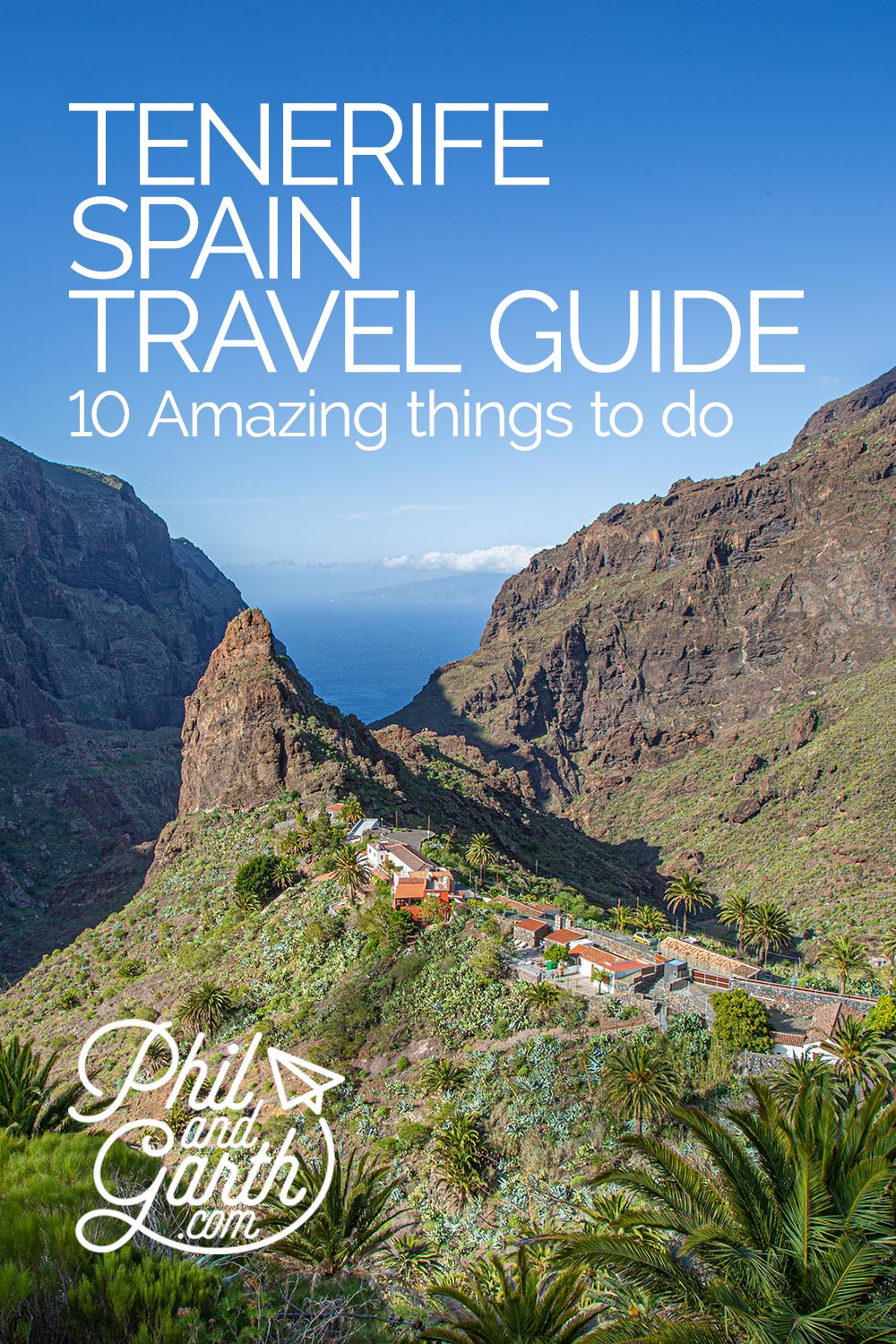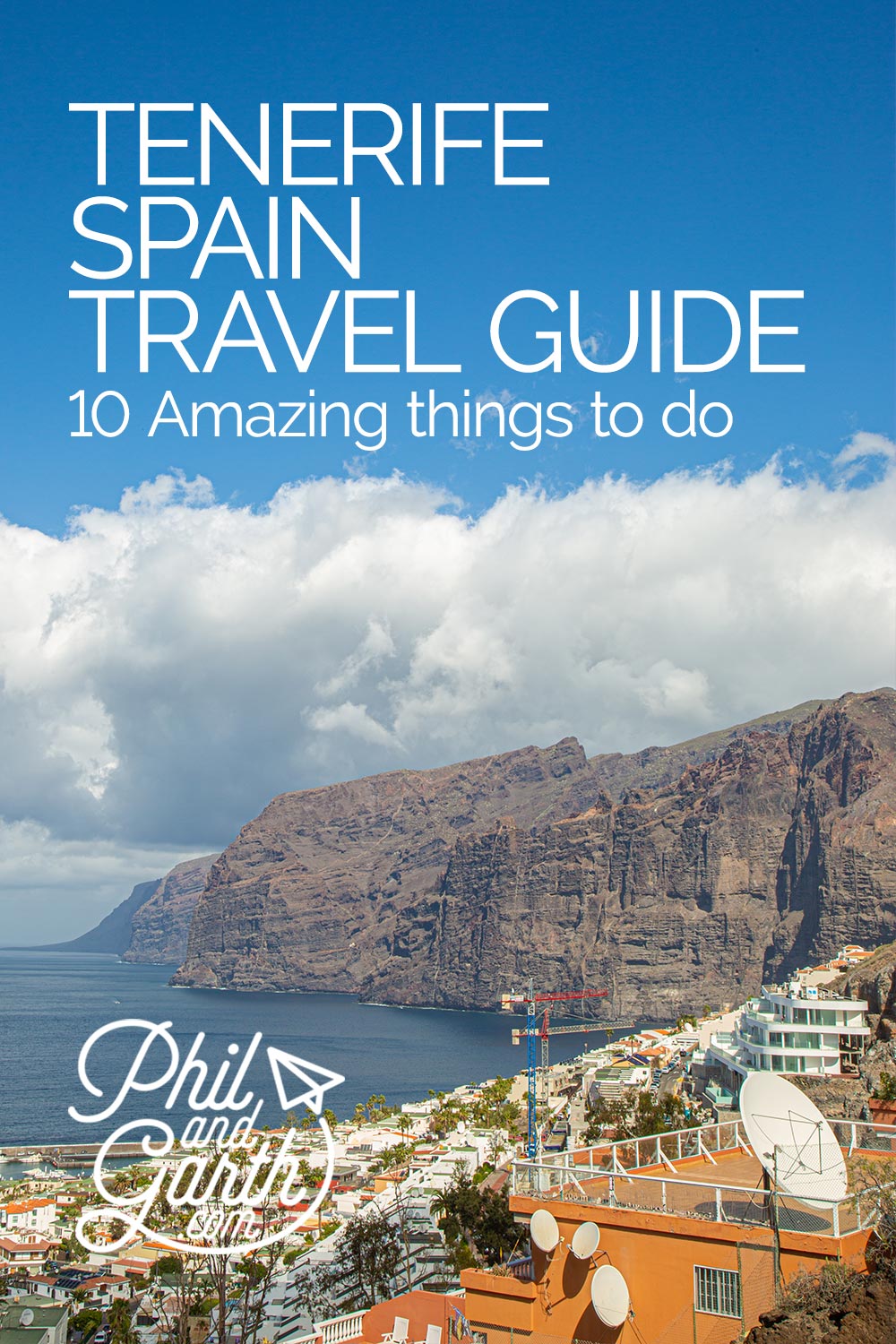Last updated: 6th April 2022
We popped over from England to Tenerife in February for a winter dose of vitamin D. Not on a typical package holiday but staying in lovely B&B. We split our time lounging by the pool, exploring unspoilt spots and finding Tenerife’s hidden gems. In this post, we’ll share our 7 day Tenerife itinerary to 10 amazing things to do in Tenerife – unspoilt places that we loved visiting. Check out our 60-second video of Tenerife above for a quick taster.
Table of Contents
About Tenerife
Tenerife is the biggest Canary Island of the Spanish archipelago and is actually closer to Morocco than it is Spain. Tenerife’s year-round sunshine, balmy subtropical climate and friendly prices attract thousands of Brits and Europeans on family package holidays. The south of Tenerife is popular with holidaymakers for its crystal clear waters, beautiful golden sandy beaches and lively resorts. Whilst the north is much quieter with dark volcanic beaches, lava formed natural swimming pools and untouched villages. Inland is mountainous with lush green pine forests, banana plantations and 900 miles of hiking trails. Tenerife’s diverse volcanic landscapes and ancient forests are a paradise for serious hikers. We loved the rural villages and historic towns for the more tranquil side of Tenerife. The island is also famous for its Rio style carnival on the run-up to Easter every year.

Tenerife is located in the middle of the Atlantic Ocean and is known as ‘The Island of Eternal Spring’
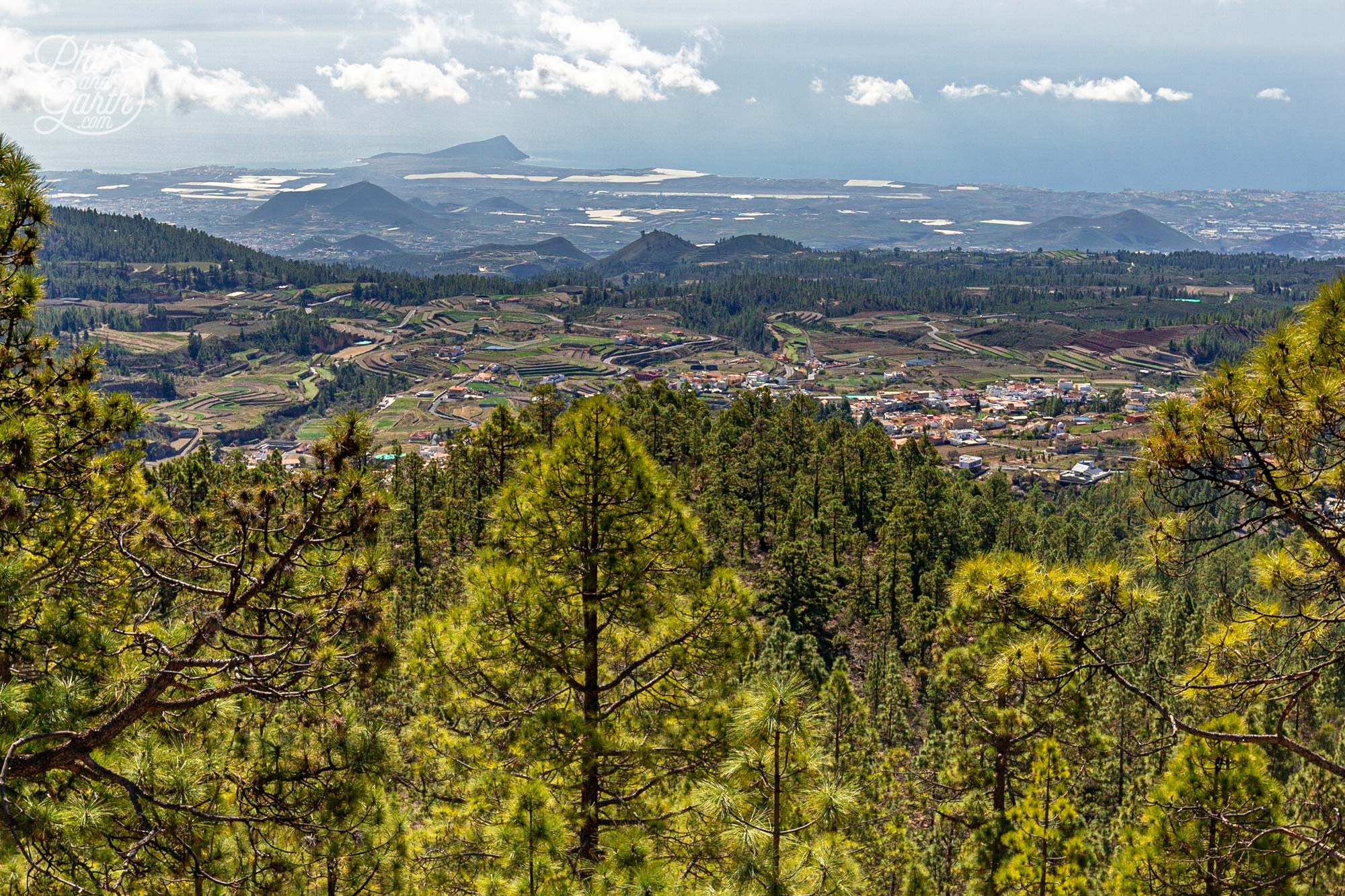
Tenerife’s diverse landscape include lush green pine forests and banana plantations

Tenerife is popular with British and German sun seekers
10 Amazing Things To Do in Tenerife
Join us as we show you our 10 unspoilt places of Tenerife, amazing places away from the beach resorts that most people never leave. So get ready to explore authentic places that are all very different from each other – old villages, lush forests and desert volcanic landscapes. Basically our list of all the best things to do in Tenerife!
1. Mount Teide & Teide National Park
Top of our list of amazing places in Tenerife is the island’s famous volcano El Teide. It’s Spain’s highest peak at 3,718 metres and the third largest volcanic structure in the world from its base after Mauna Loa and Mauna Kea in Hawaii. It’s an active volcano that last erupted back in 1909. Thankfully for us it’s currently dormant and it’s closely monitored for tremors. Phew!
El Teide is colossal and is impossible to miss, even from a distance, which reminded us of seeing Mount Fuji In Japan. To get there we drove up the mountains and into the Teide National Park which is a protected wilderness and also a UNESCO World Heritage Site. The landscape is otherworldly, just like the neighbouring islands of Lanzarote and Fuerteventura. Tenerife’s lunar landscape is full of strange volcanic rock formations and big expanses of lava fields. What immediately struck us is there are no trees just moments after driving through a dense pine forest to reach the park.

The mighty volcano, El Teide is Tenerife’s must see natural sight
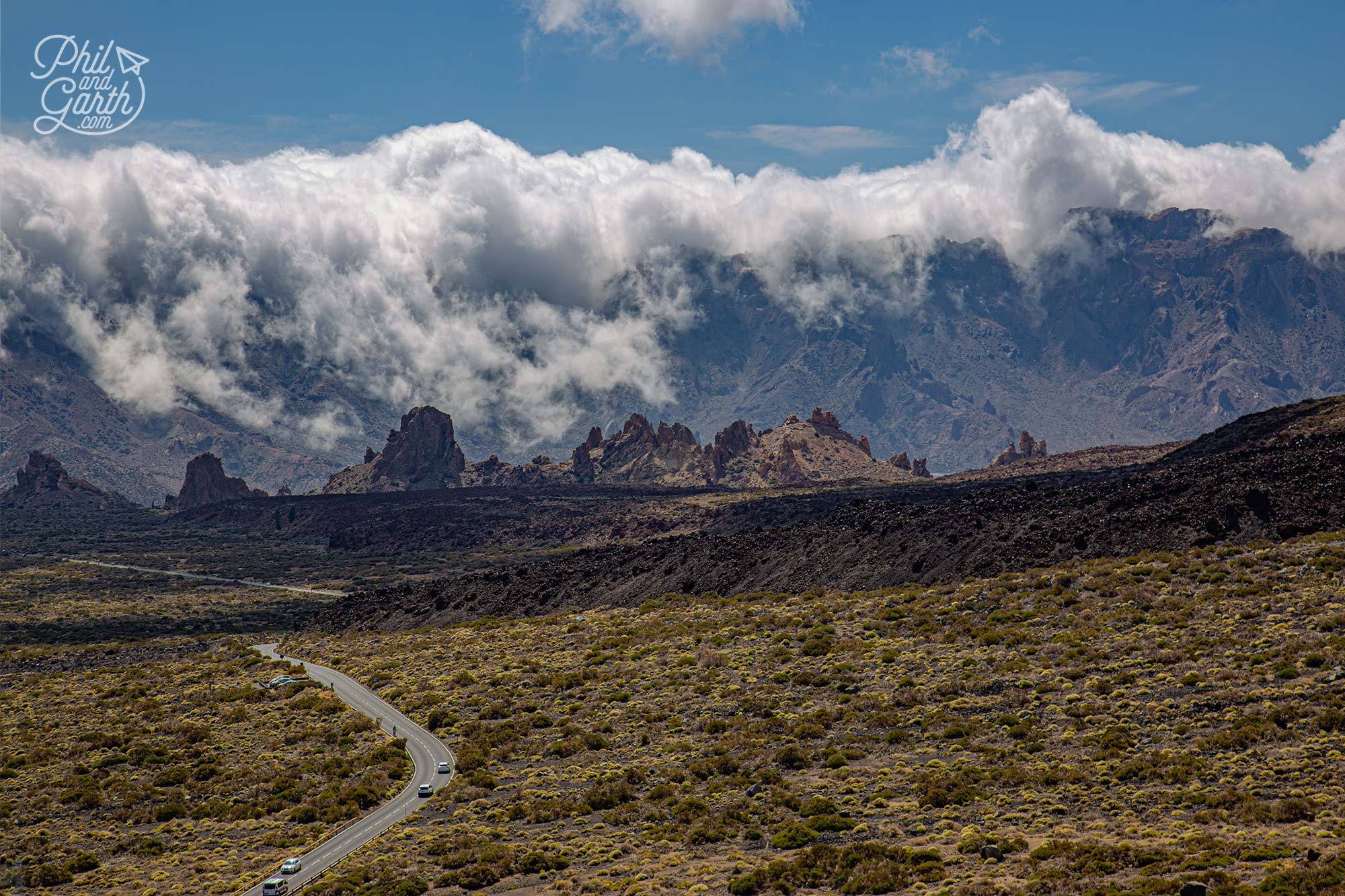
Teide National Park is the most visited national park in Europe

Otherworldly moonscape with a unique biodiversity
From the base of the volcano you can hike to the top of the crater which takes 5 hours but you’ll need to purchase a permit in advance. We took the more sensible cable car option with the optional Pico Viejo guided tour. It only takes 8 minutes to travel up 3,555 metres just a little short of the summit at 3,715 metres. At the top of the crater the views are spectacular as you can imagine. It’s difficult to grasp the vast scale looking down on a sea of clouds. We hoped to walk to the Pico Viejo viewpoint with a guide but the tour was cancelled because there was too much snow. Apparently on a clear day you can see the neighbouring island of La Gomera and Gran Canaria in the distance. Make sure you wear warm clothes for the cold weather at the top.

The El Teide cable car takes takes 8 minutes to travel up 3,555 metres

Breathtaking views from the top of the El Teide volcano
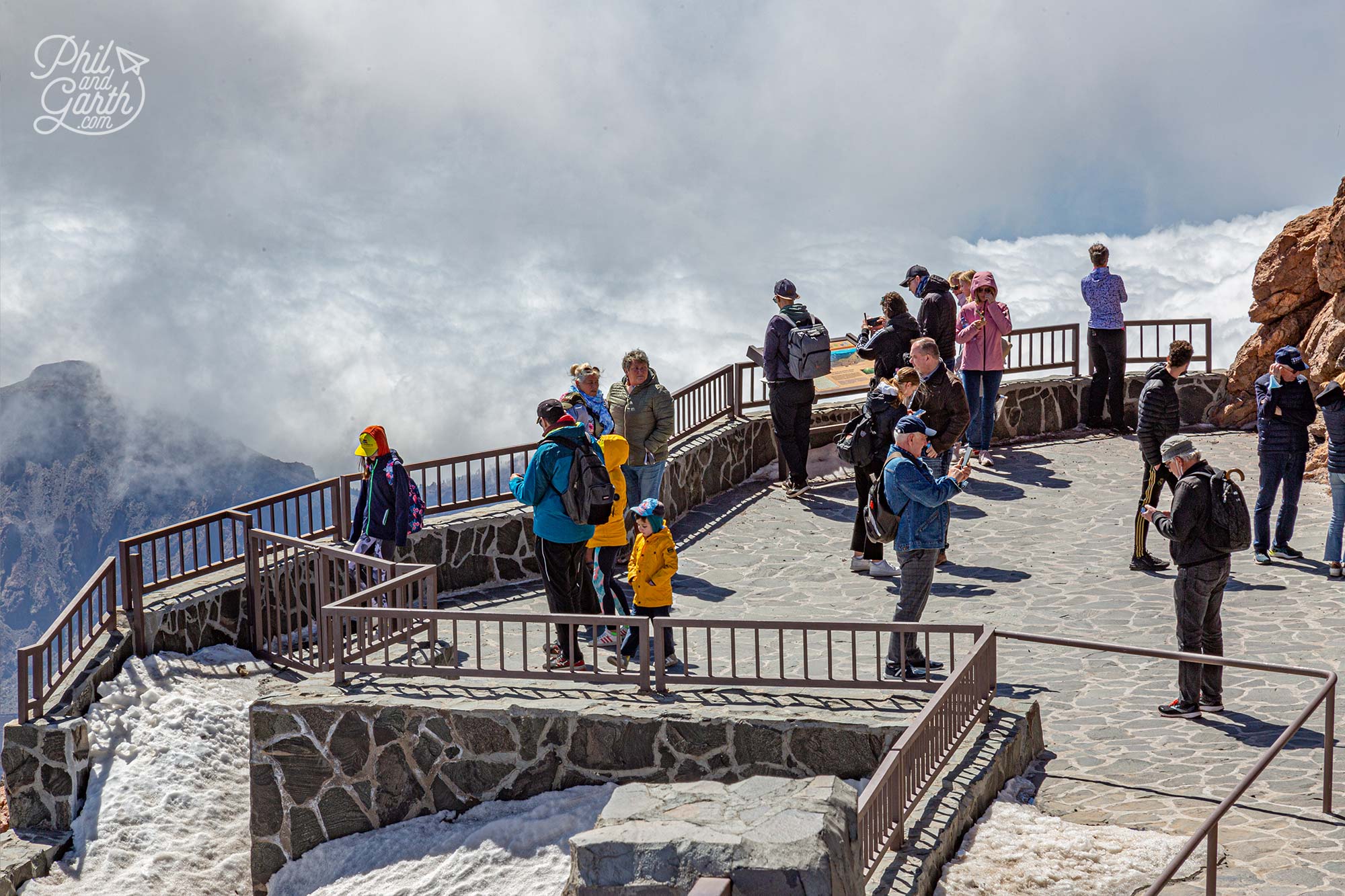
Looking down on a carpet of clouds from the top of El Teide

The view of the summit from the viewing platform which is just 160 metres below
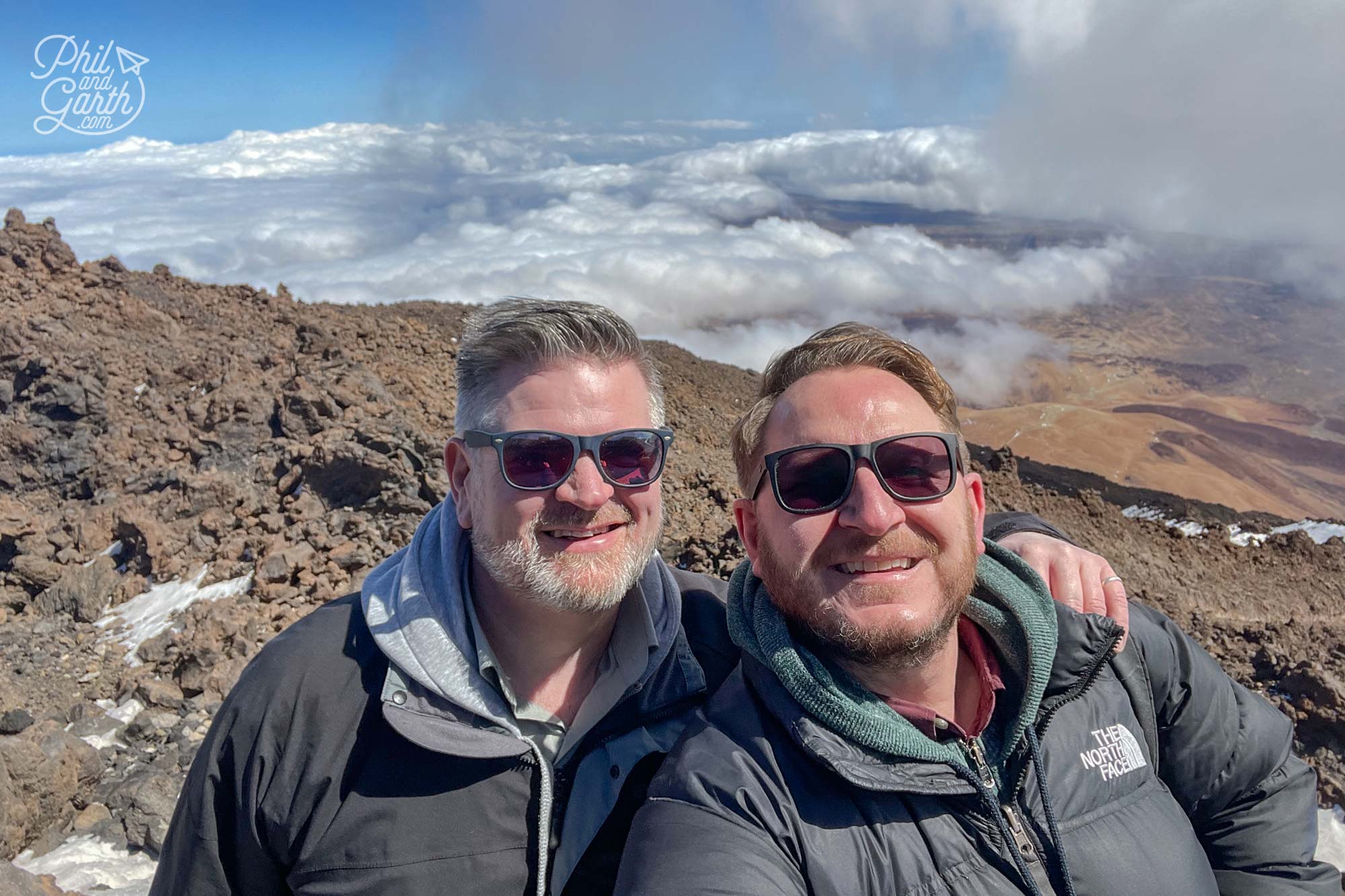
You’ll need to wrap up warm at the top of El Teide
At different times of the year El Teide is covered in snow, worth noting on windy days if conditions are bad the cable car will be closed, so check ahead to see if it’s open. You will need to buy the pricey return tickets in advance on their website volcanoteide.com and turn up 20 minutes prior to the boarding time. Don’t chance it on the day because only 200 walk-ins are allowed to go to the top each day. If you’re visiting Mount Teide in the summer it’s recommended you get there after 12 noon once the majority of tourists buses have been, oh and Wednesday is the busiest day. We booked our ticket for a 12.50 pm slot which cost £85 for both of us.
2. Roques de García
Before you leave the Teide National Park make sure you go for a walk and take some photos at Roques de García. This collection of unusual rock formations attracts lots of visitors throughout the day. The most famous rock here is Roque Cinchado which is a landmark of Tenerife. It used to feature back in the day on the old 1,000 peseta banknote. It looks like a weird tree about to topple over. Its shape has been moulded by erosion through wind and temperature changes at its base. Experts believe one day it will eventually collapse. There’s an easy 2 hour circular trail if you fancy walking around this collection of unusual volcanic rocks.

The rock formations of Roques de García between us in the Teide National Park

Roques de García – fascinating rock structures in the Teide National Park
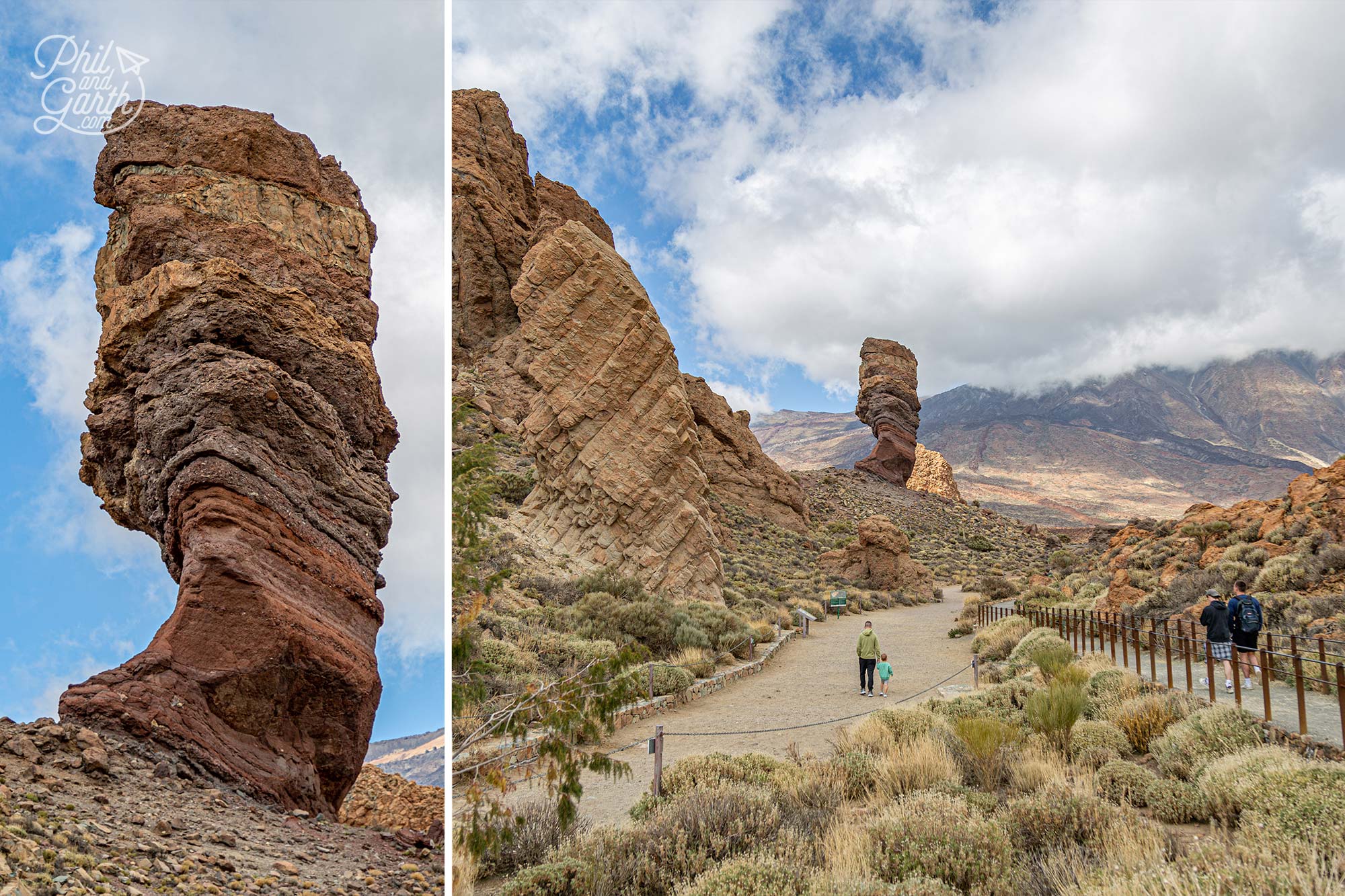
The curious shape of Roque Cinchado – Tenerife’s most photographed rock

The views around Roques de García are epic
Leaving the national park on the way back to our B&B we stopped off in Vilaflor at a traditional Spanish restaurant called Finca Tres Roques. It does some of the best authentic Canarian food in Tenerife. Garth had the charcoal-grilled chicken with red mojo sauce and chips made from their own potatoes whilst Phil had the slow-cooked Iberian suckling pork. We can highly recommend this place because the food was amazingly tasty. Getting there is not the easiest because it’s well off the beaten path.

Delicious and authentic Canarian food at the Finca Tres Roques restaurant
3. Masca Village – The Machu Picchu of Tenerife
Masca is a tiny and remote mountain village hidden in the Teno Mountains on the west side of Tenerife. Hikers come here for beautiful walks through the lush forest landscape and the challenging 3 hour trail down the Masca Canyon to the beach below. We wanted to see the fabulous views and the traditional cottages that cling to the side of the mountain slopes. Masca is a unique place home to just 90 people.
It’s often referred to as the Machu Picchu of Tenerife because of the tall mountain that looks similar to the Huayna Picchu mountain seen in the Incan city of Machu Picchu high up in the mountains of Peru. What’s amazing is that the road to Masca was only built in 1991, so residents were previously really isolated and used donkeys to reach the world outside.

What an incredible sight – the Masca village high up in the mountains with an altitude of 650m

Phil and Garth at Masca Village – The Machu Picchu of Tenerife
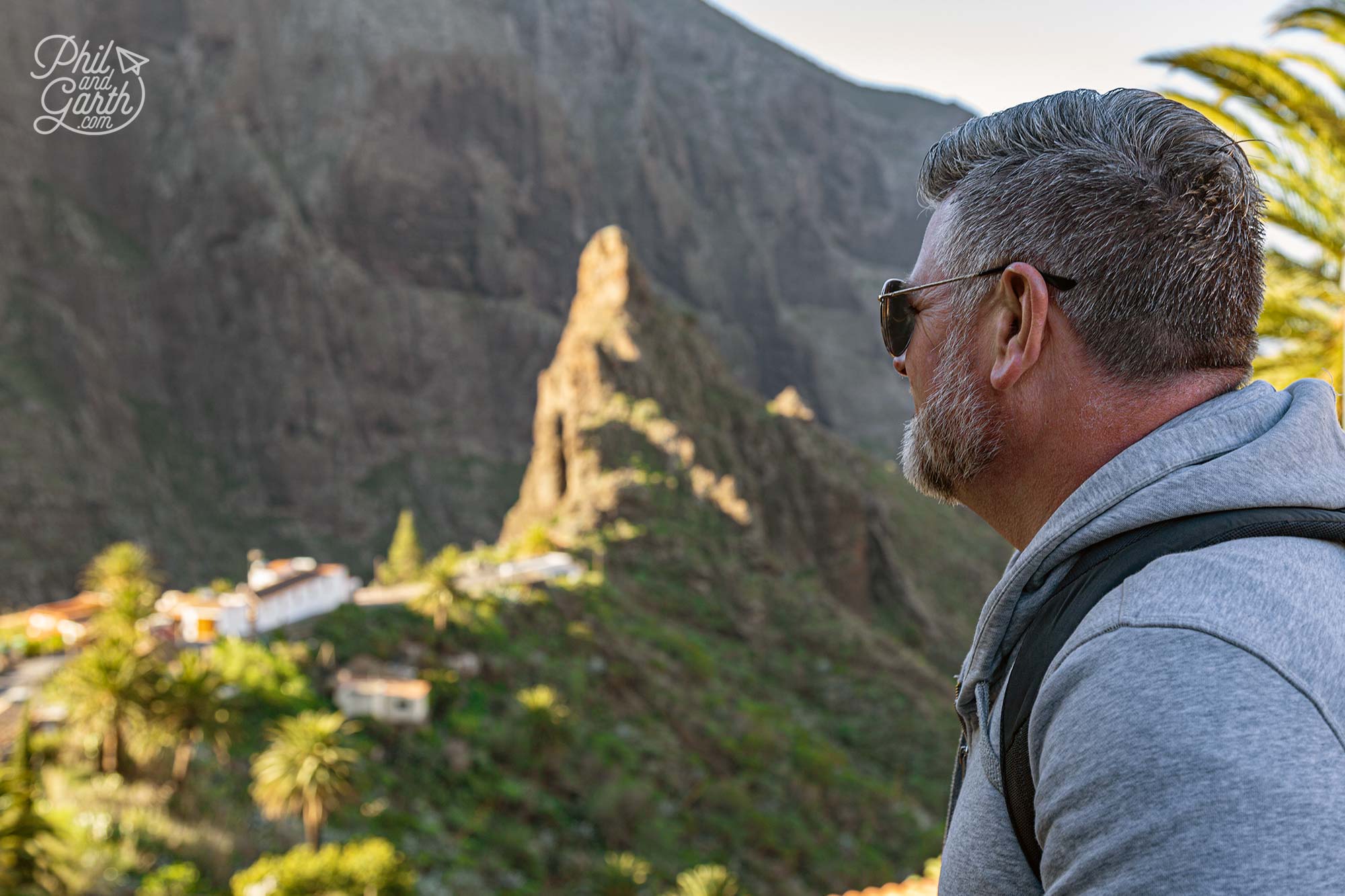
Phil taking in the views of Masca, Tenerife’s most dramatic village

Restaurante El Guanche has great views from their terrace
The views are extremely pretty, Masca is such an incredible sight. There’s a small museum plus various restaurants to visit. El Guanche has the best views from its terrace.
The road to Masca is incredibly scenic but super narrow. Be warned it’s full of hairpin bends and twists so it’s not for the faint-hearted as you’ll need to reverse if you meet oncoming traffic. Car parking spots are incredibly limited in Masca so we recommend getting here before 10am before the bus tours as there will be nowhere to park between 11am and 2pm. We got there at 9am and it was about a quarter full. Also, make sure your car is full of fuel as you will end up driving really slow in 1st gear most of the time and you certainly don’t want to break down here!

It’s worth the hair raising journey to get to Masca
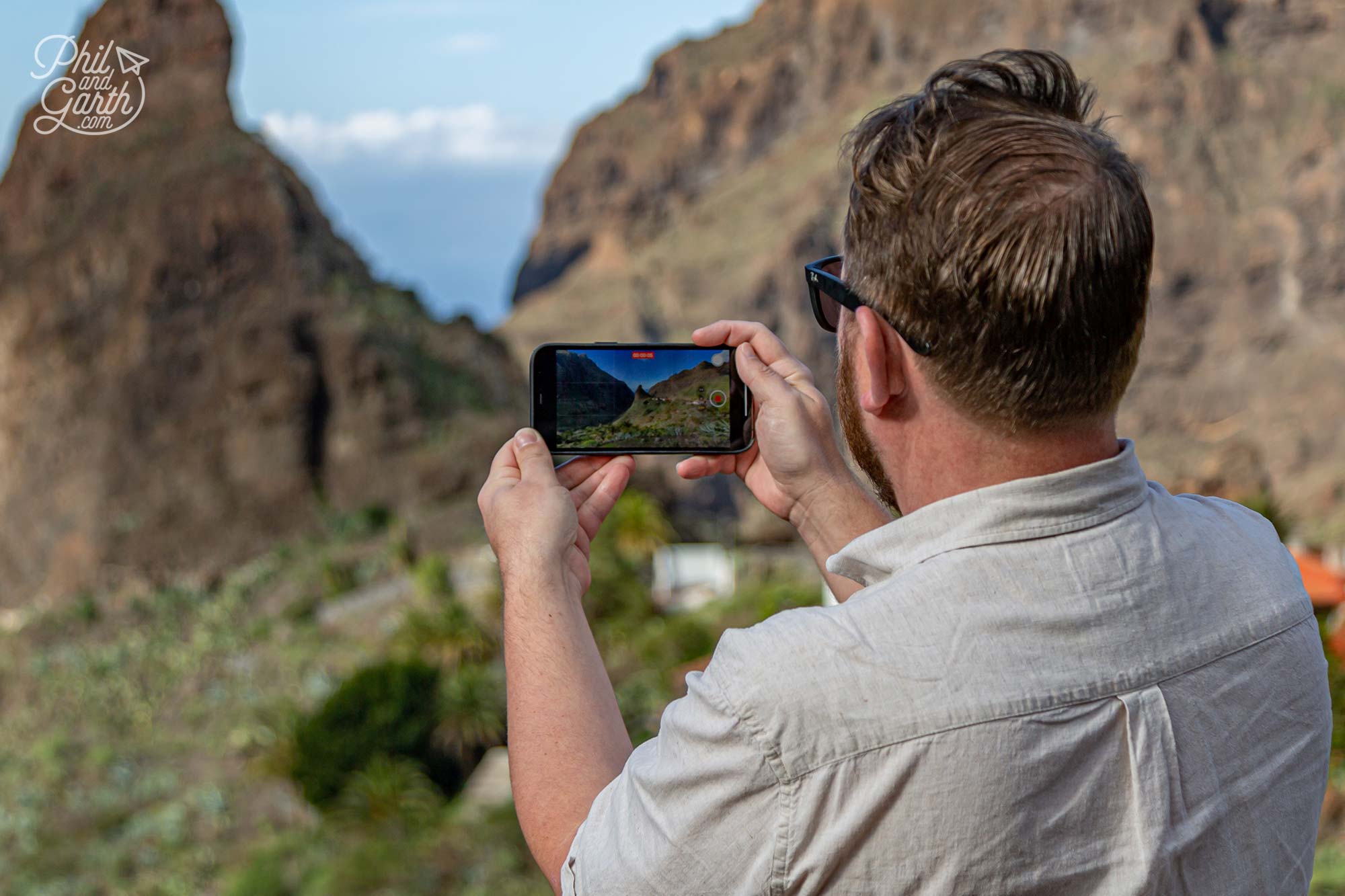
Garth shooting some video on his iphone
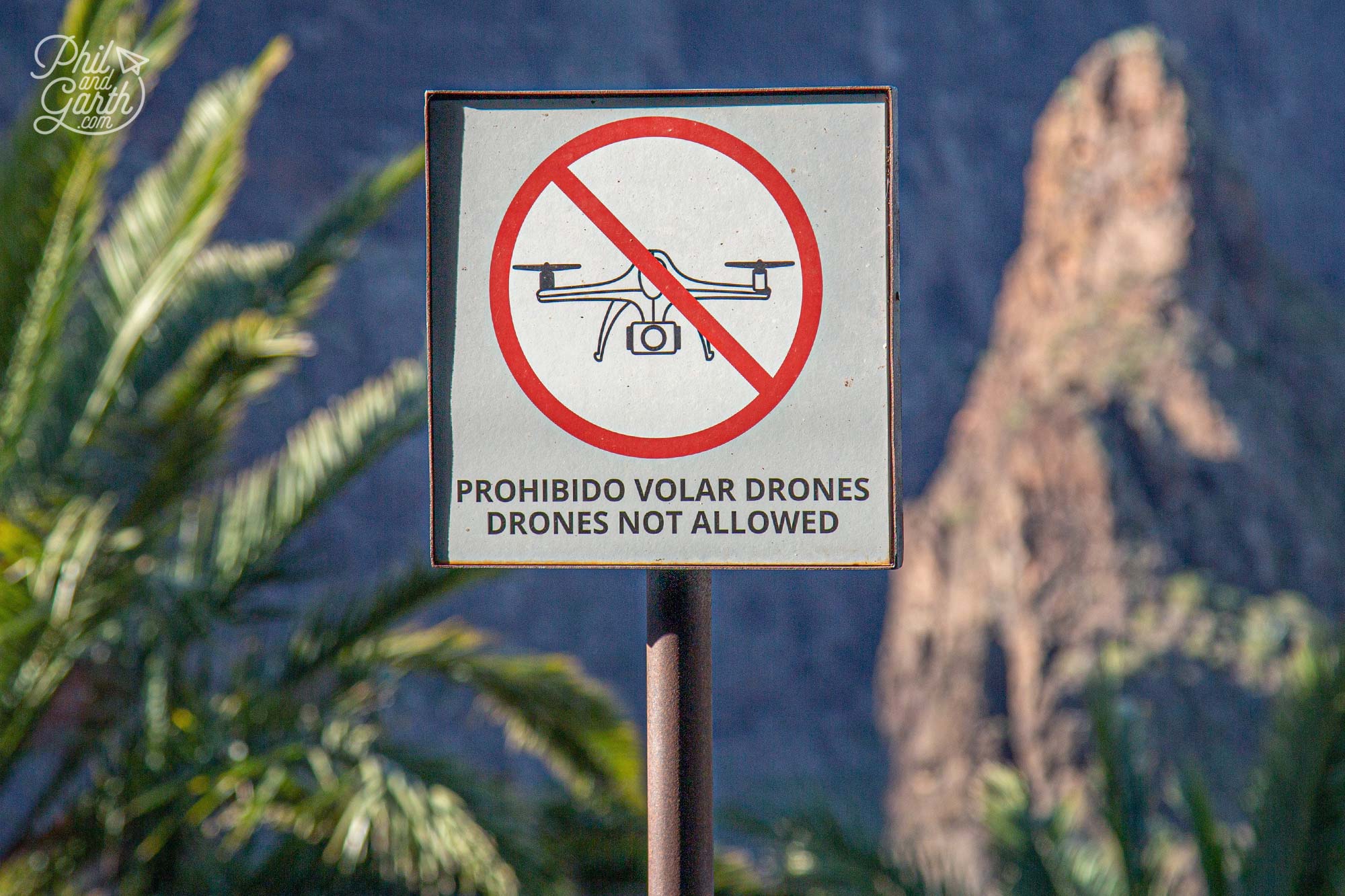
You are not alllowed to fly drones at Masca Village
4. El Puertito
El Puertito is a perfect example of what Tenerife’s small fishing villages looked like before mass tourism took over these sleepy places in the 1970s with high rise hotels. It’s a hidden gem of Tenerife just a few miles from the busy resort of Playa de las Américas.
The small harbour and the enclosed bay are little delights. It’s unspoilt and authentic. On weekends locals come here to quietly enjoy the small beach at low tide. We parked in the small car park, it’s cash only and closes at 6.45pm. There’s not much here in El Puertito apart from a bar, the beach and a few hippie vendors selling some jewellery.
There’s just one bar here, Bodegon Pepe y Lola, a nice spot for some tapas overlooking the small bay. However, it gets super busy so you have to be patient like we did and wait your turn for a table. We watched a few boats pull up in the bay where people dived in to go snorkelling. Apparently, the bay attracts many turtles.
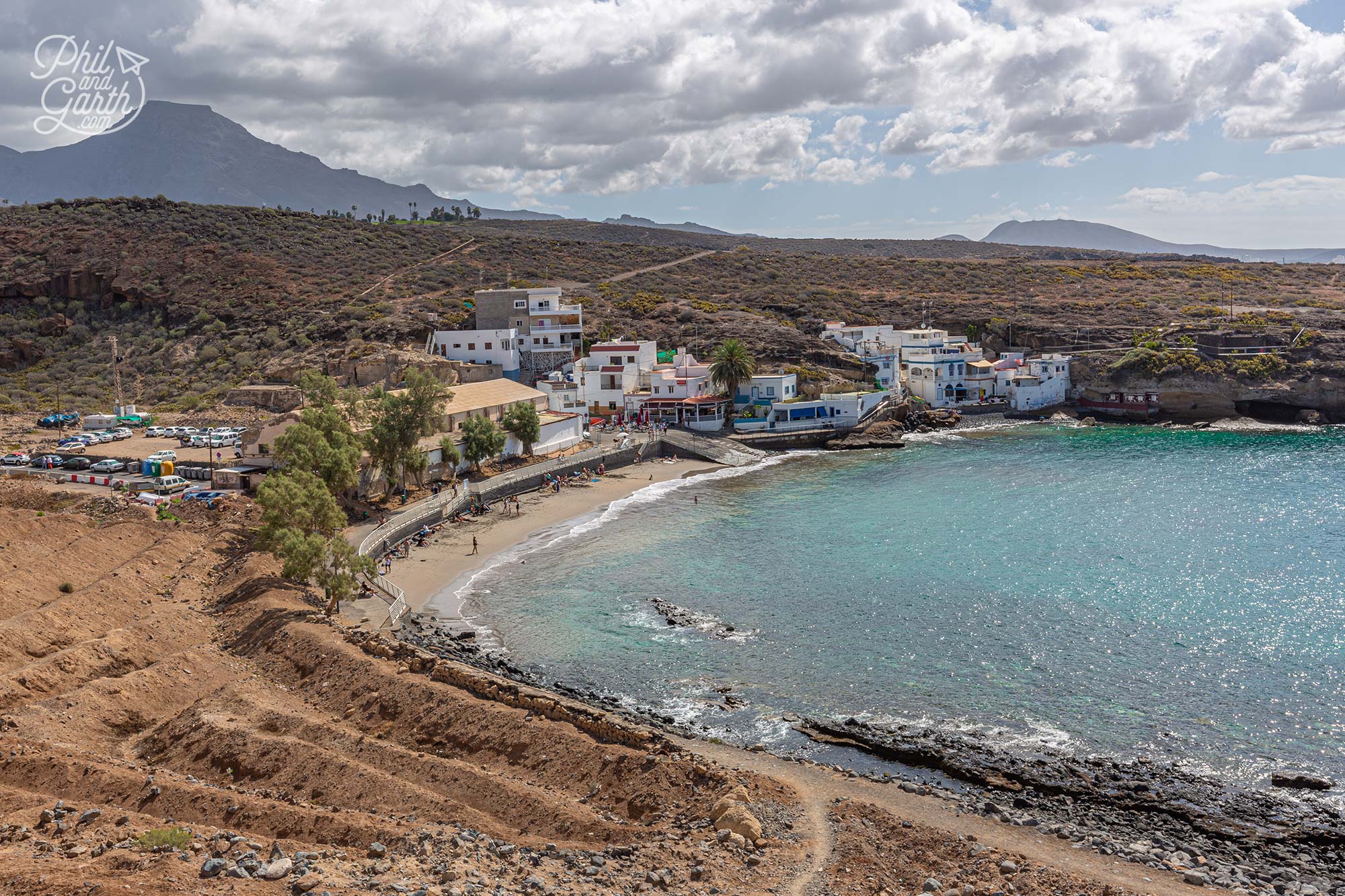
El Puertito is a lovely hidden gem in Tenerife

There’s just one bar here, Bodegon Pepe y Lola, a delighful spot for some tapas overlooking the small bay

El Puertito is a charming little place to spend a few hours
5. Los Gigantes cliffs
Our 5th amazing place in Tenerife is Los Gigantes on the west coast of the island. It’s a small town home to the largest cliffs of all the Canary Islands. Los Gigantes means ‘The Giants’ and these gigantic and dramatic cliffs certainly live up to their name. They soar above the ocean 800 metres high.
We parked at the marina where there are lots of good restaurants. Walk a little further on from the marina and you’ll find the modest-sized Los Guios black beach. It’s the perfect place to take some dramatic looking photos or watch the sunset over the cliffs as many people like to do here. The view from the Mirador Archipenque viewpoint up the hill is pretty good too.

The striking giant rock face and cliffs of Los Gigantes
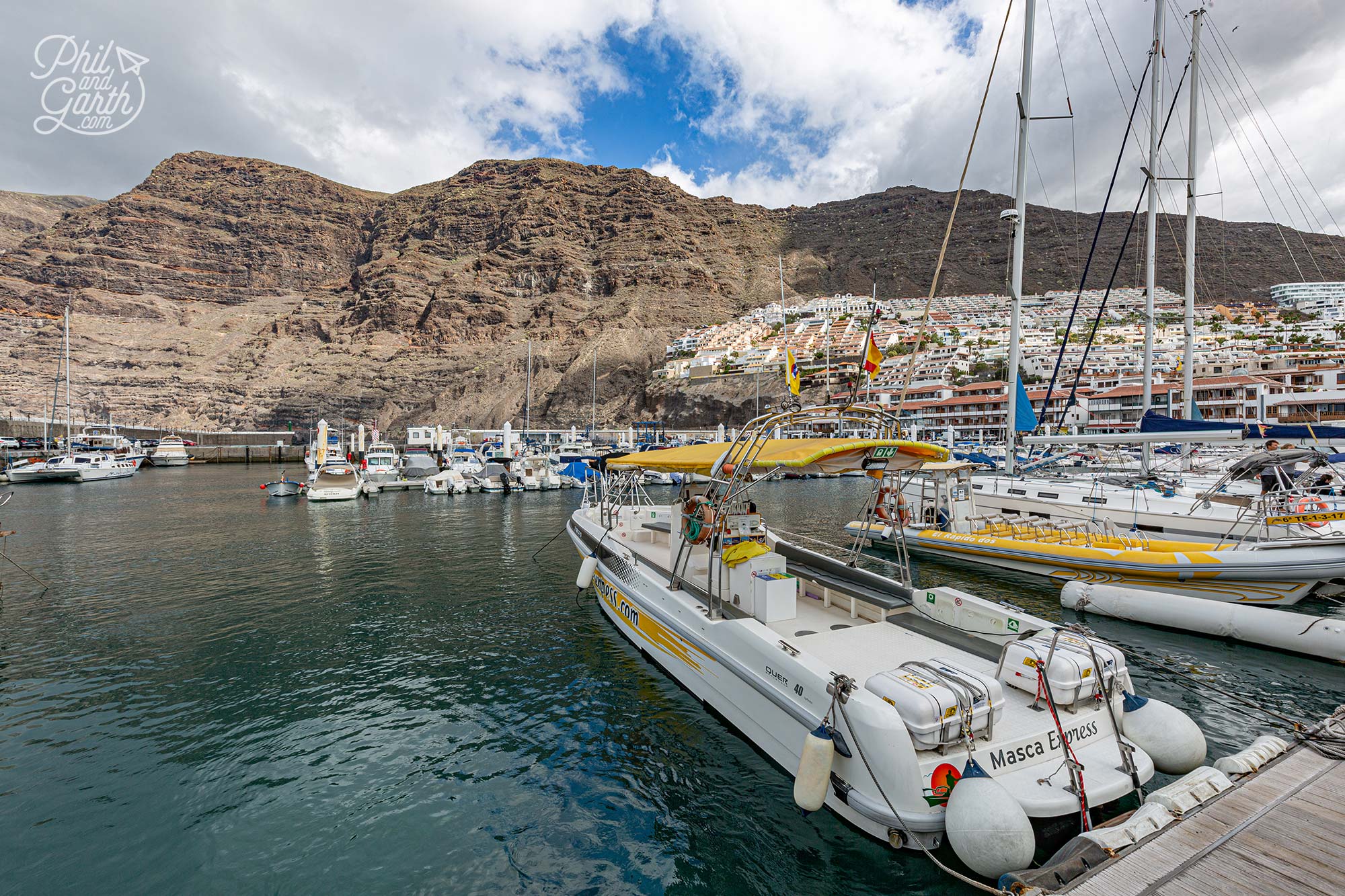
Dolphin and whale watching boat trips leave from Los Gigantes pretty marina
From the Los Gigantes marina, we caught a 2-hour dolphin and whale watching boat trip with Masca Express. A boat trip offers one of the best ways to view and appreciate the sheer scale of the cliffs from the sea. December to May is the best time to view bottlenose dolphins and Tenerife’s colony of pilot whales. The cliffs provide protection from the elements and the warm waters found here are what attract these marine species.
Our boat trip was super bumpy because of high winds and the sea swell and yes at times we both felt very sea sick. However, we did see lots of dolphins but no whales. The dolphins were easy to spot because seagulls hover over them. Our boat trip finished with a stop off in the bay where the Masca Valley hike finishes at the small beach. Apparently, this area is great for snorkelling and diving, however, it was too cold for us to jump into the sea, although one brave person on our boat did! We stuck with the views and a free can of beer. Up close to the cliffs you can see all the different colours in the rock.

Los Gigantes is a hotspot for dolphin and whale watching boat trips

Searching for bottlenose dolphins and pilot whales

Another striking rock face at Los Gigantes

We got slightly wet at times bouncing around the waves
6. La Orotava
La Orotava is set in an area of Tenerife surrounded by banana plantations and a lush green valley. La Orotava’s historic old town is nicely preserved and a real delight to visit. It’s full of colourful traditional architecture with ornate wooden balconies that date back to Spanish colonial times. Garth loved all the photo opportunities here. Phil enjoyed the ambience of traditional Tenerife wandering around the old town’s sleepy cobbled streets some lined with palm trees.

So many pretty spots like this – Plaza Patricio Gracia
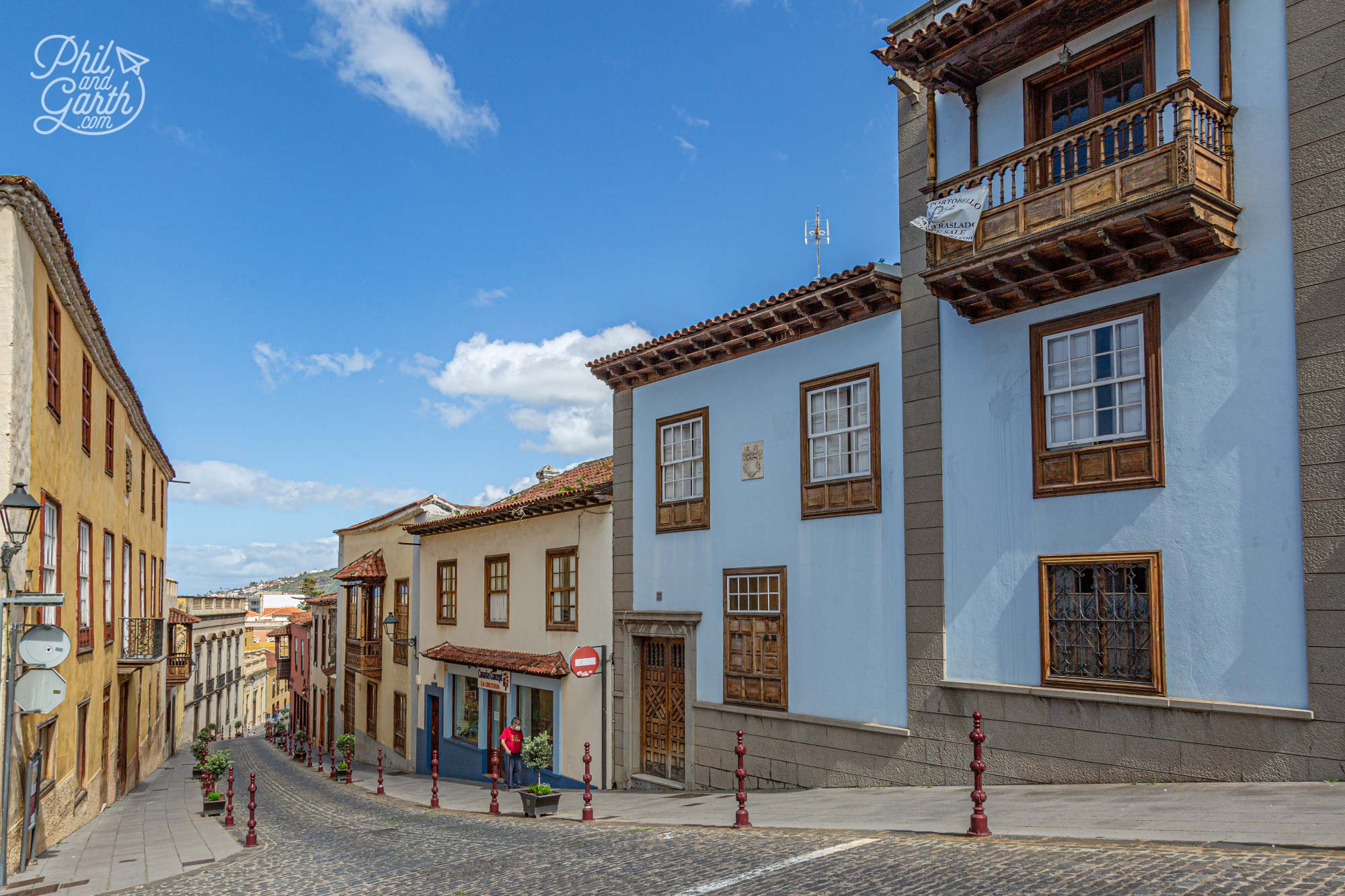
So many photo opportunities in La Orotava’s traditional streets
First up we visited La Orotava’s main attraction – Casa de Los Balcones, the ‘House of Balconies’. Your ticket price includes entry to 3 separate buildings. Starting with Casa de Los Balconies – a traditional 17th-century family home. It’s now a museum showcasing the family’s collection of antiques and another area has demonstrations of traditional lace making. The pretty interior courtyard is typical of these elite family homes designed to be kept cool in the shade. Intricate hand-carved wooden balconies surround the courtyard and were designed to show off a family’s wealthy status.

Standing on the old wooden balcony at Casa de los Balcones

Garth at Casa de los Balcones
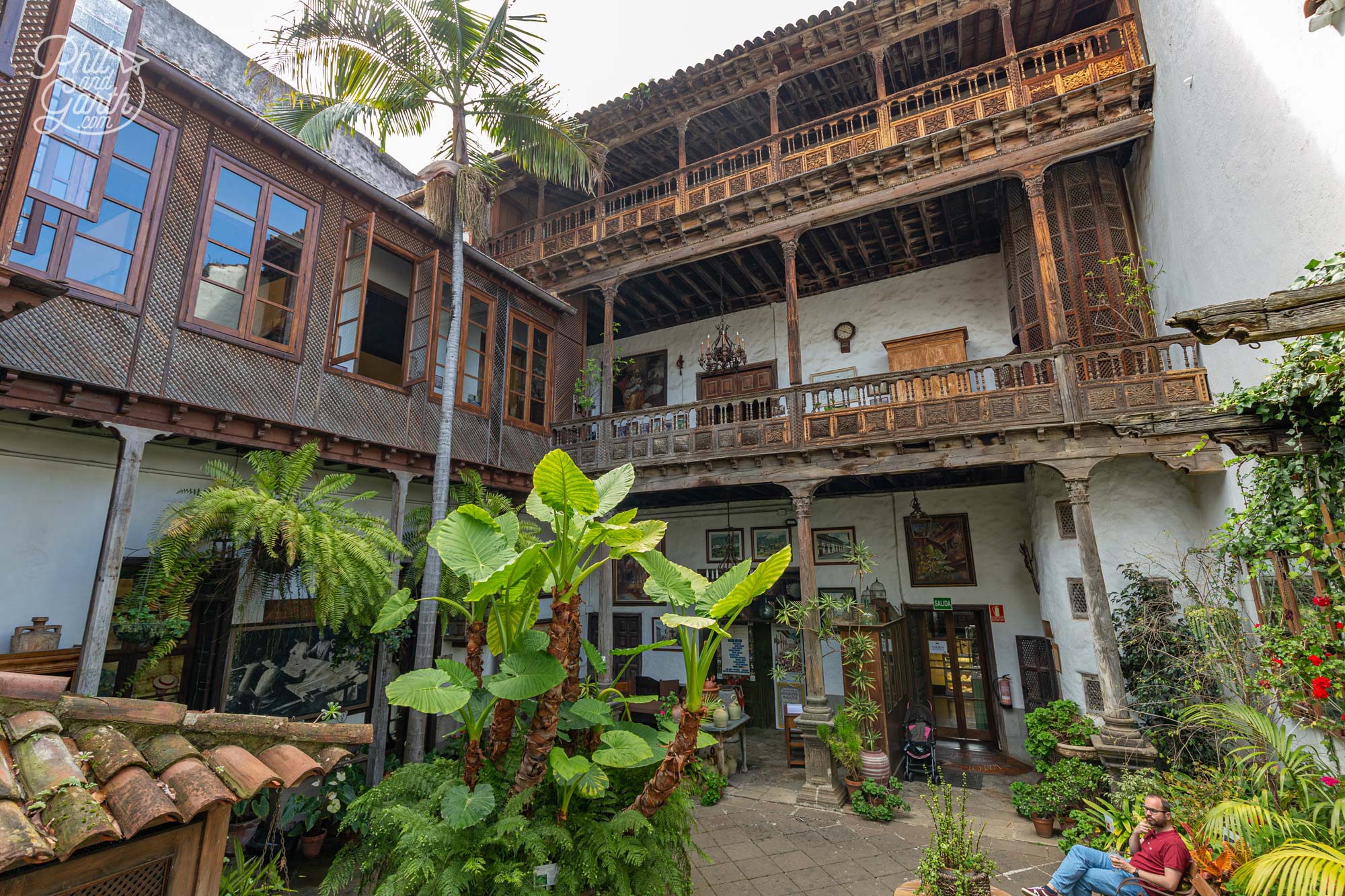
The traditional interior courtyard surrounded by intricate wooden balconies

Casa de los Balcones is a nice little museum
Come out of Casa de Los Balconies and immediately opposite is the second building, Casa Eladia Machado which showcases Canarian arts and crafts. Exhibitions include a gallery with paintings of Tenerife by Egyptian artist Mohamed Osman. There’s a ceramics workshop but we can’t help thinking this mansion feels more like one very fancy souvenir shop.
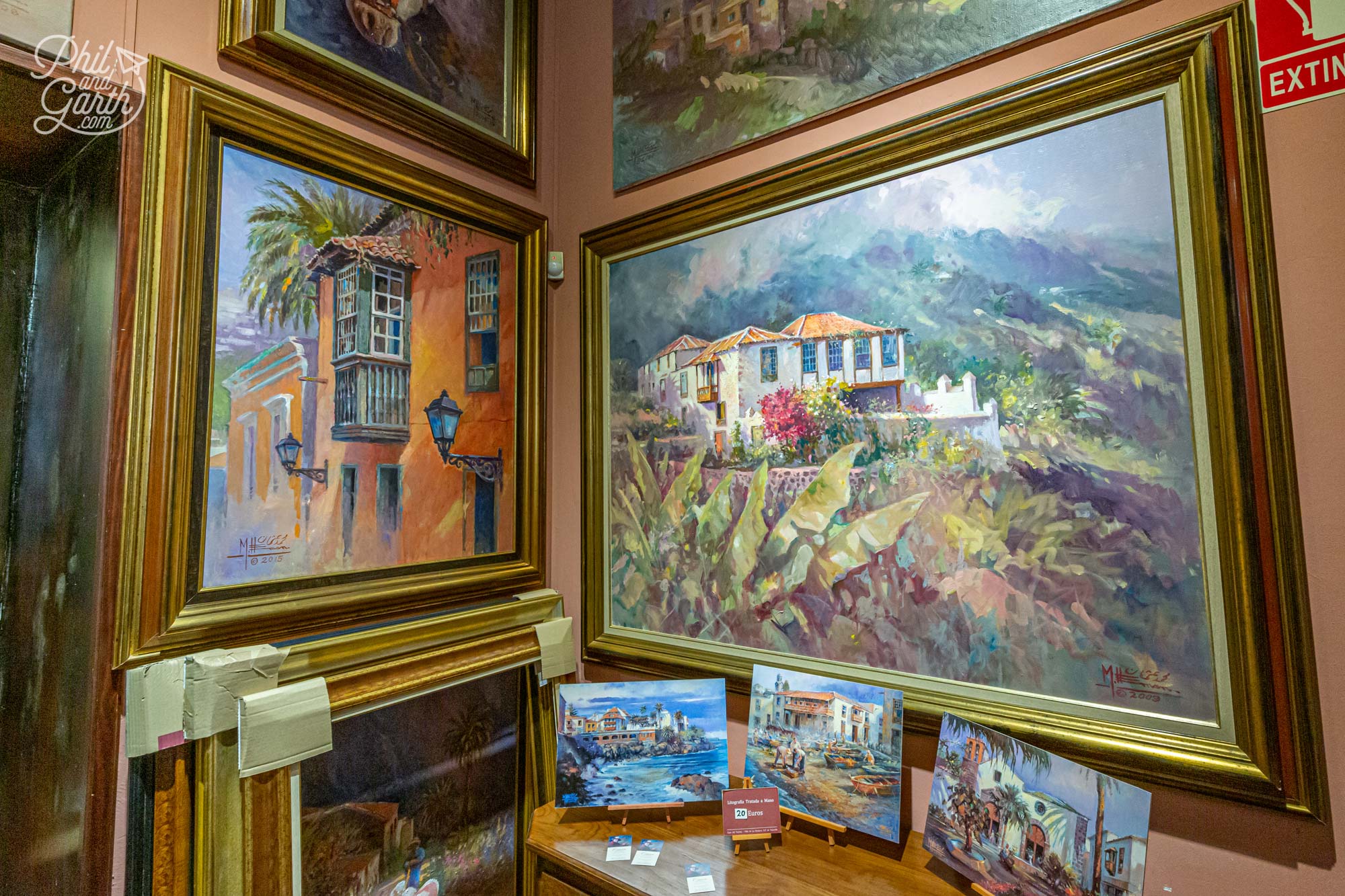
Casa Eladia Machado which showcases Canarian arts and crafts
The final house is Casa Lercaro – another 17th-century mansion now converted into a restaurant. It has a lovely atmosphere and features a cool interior courtyard. We had lunch here and it was wonderful, we both loved the relaxed and unpretentious atmosphere. We ordered fish dishes, slightly less well done than we would have liked but nevertheless very tasty and so fresh. It’s a lovely setting for drinks or food with friendly and attentive waiters.
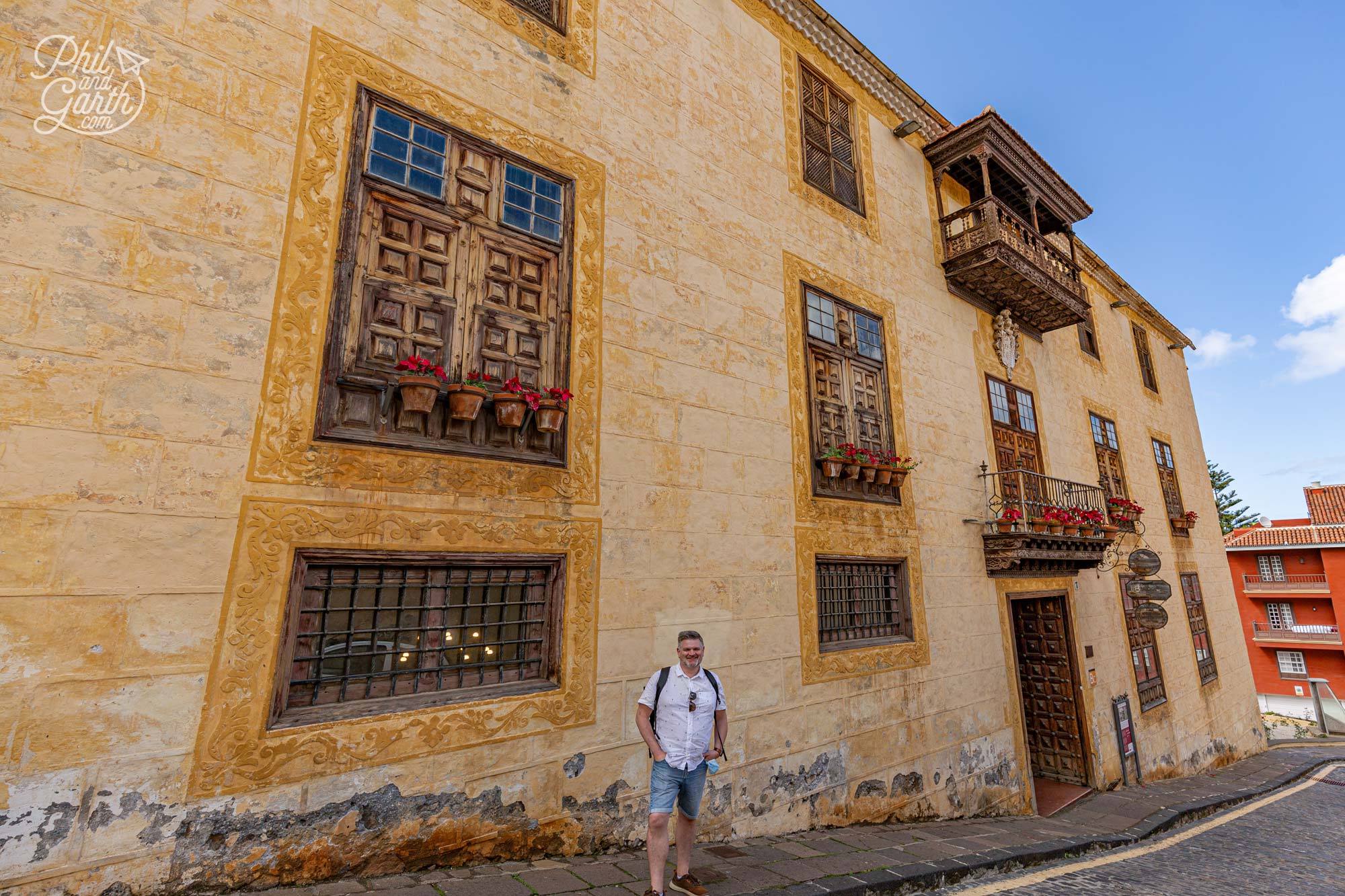
Phil stood outside Casa Lercaro, a great restaurant with Good food is served as well, fresh and unpretentious food

the impressive entrance to Casa Lercaro

Gorgeous setting inside Casa Lercaro with a lovely relaxed atmosphere

Garth ordered the tuna with Canarian red mojo sauce and potatoes

A lovely setting with friendly and attentive waiters
Other sights to check out in La Orotava include one of Tenerife’s most beautiful churches – Iglesia de Nuestra Señora de la Concepción, the stunning flower displays at Jardín Victoria (see below) and the streets around Ayuntamiento Plaza.

Iglesia de San Agustin – this church and former monastery was built in the 17th century
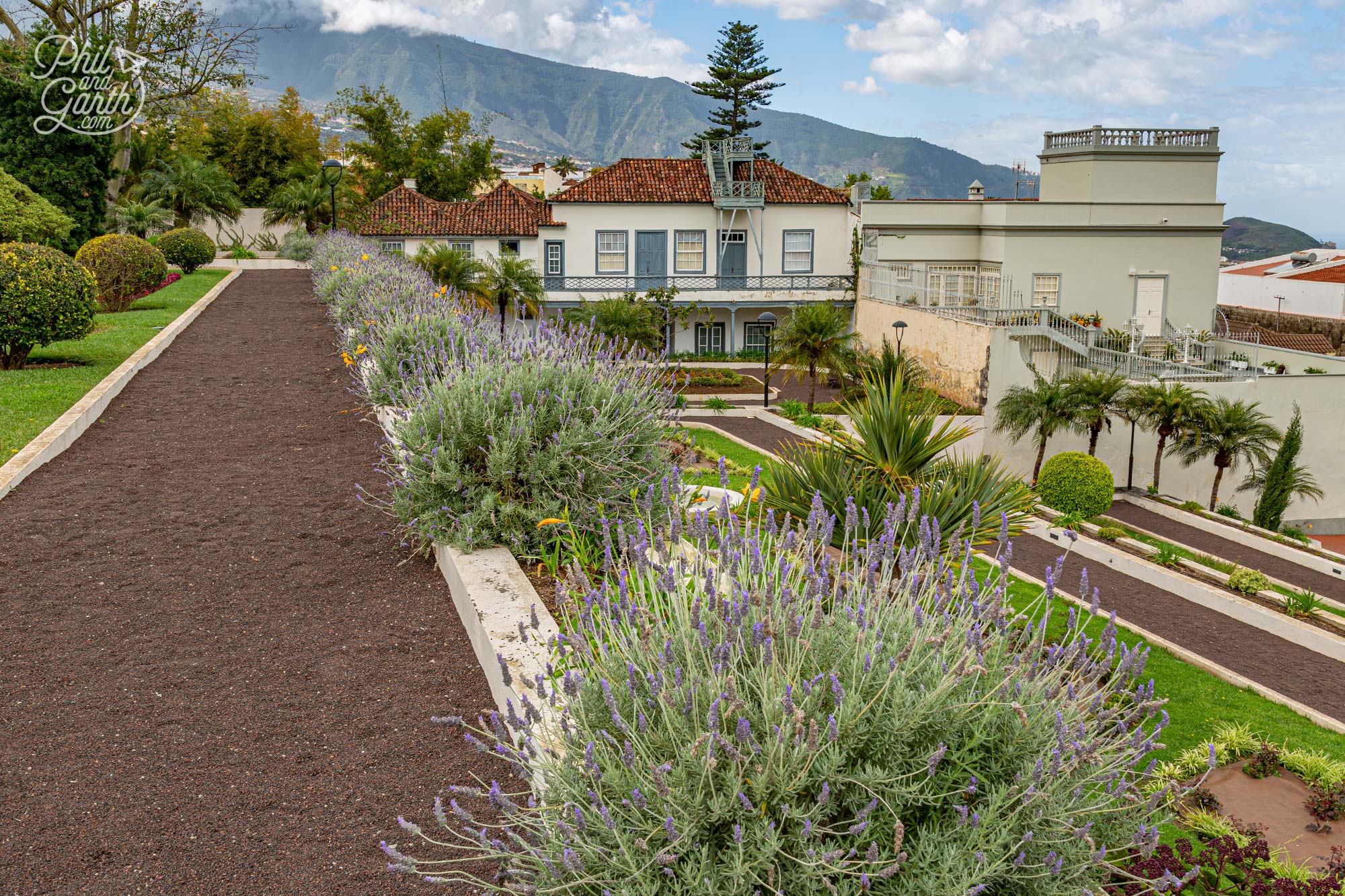
The gardens are beautiful and well designed with lots of fountains

The gardens are very relaxing and offer stunning views of La Orotava. There’s also a nice cafe in the gardens

Jardín Victoria – a lovely spot on a hill in La Orotava

Opposite Jardín Victoria is a small Botanical Garden, well worth a look around
7. Millenary Dragon Tree
Whilst on the way to Garachico take a quick stop at Icod de Los Vinos to see El Drago Milenario. Better known as the Millenary Dragon Tree it’s become an iconic landmark of Tenerife that you’ll see on all the postcards. The dragon tree is the oldest living specimen in the world and is thought to be around 1,000 years old! However, more recent studies put it at around 500 years old. Its name comes from a legend that says when dragons die they become trees and the red resin inside the tree is the dragon’s blood. You can view it from the town square, so you don’t need to pay the entrance fee to the botanical park. However, If you want to go into the Parque de Los Dragos it’s open from 9.30am to 6.30pm.
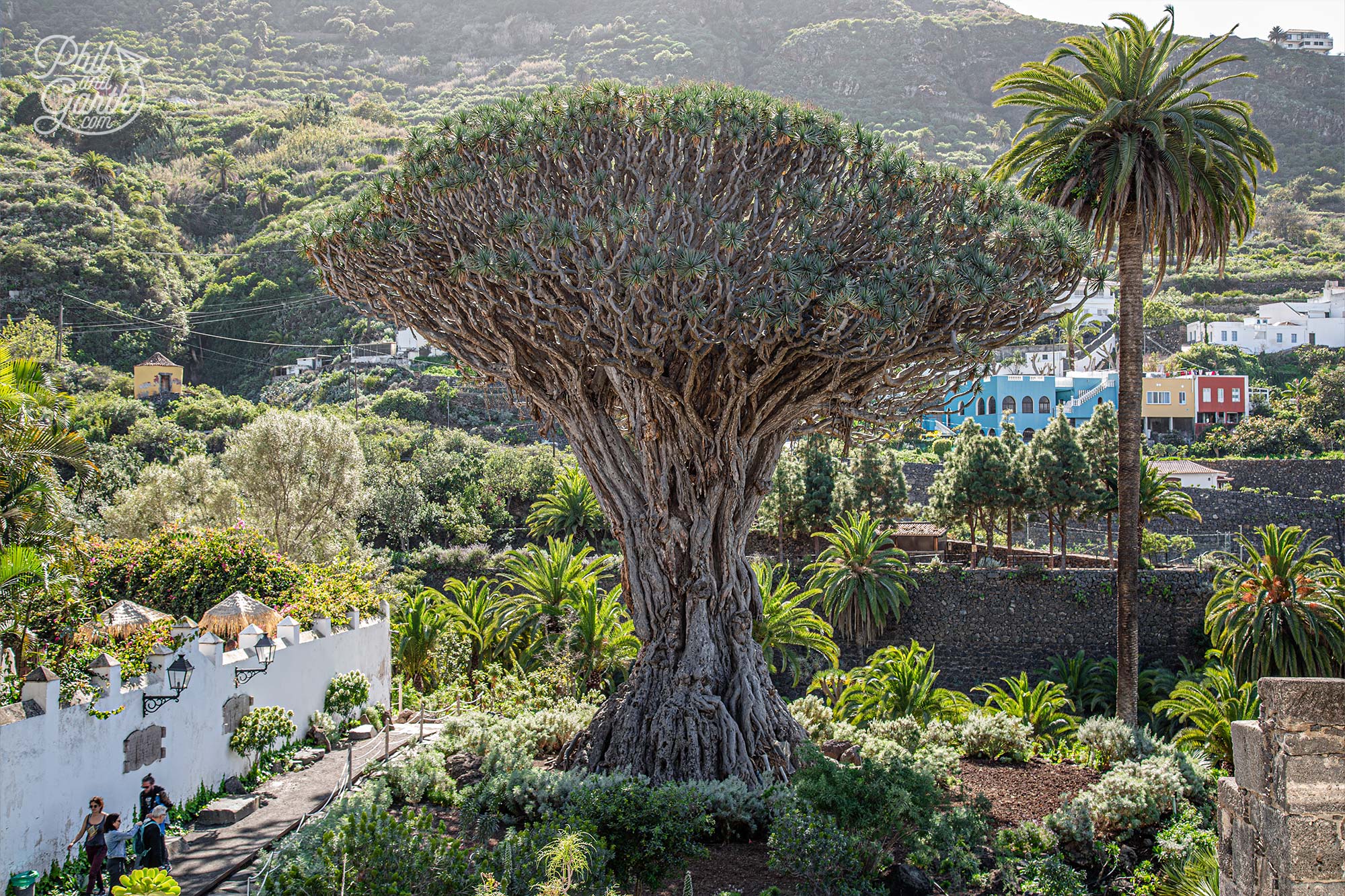
The Millenary Dragon Tree is the oldest living specimen in the world
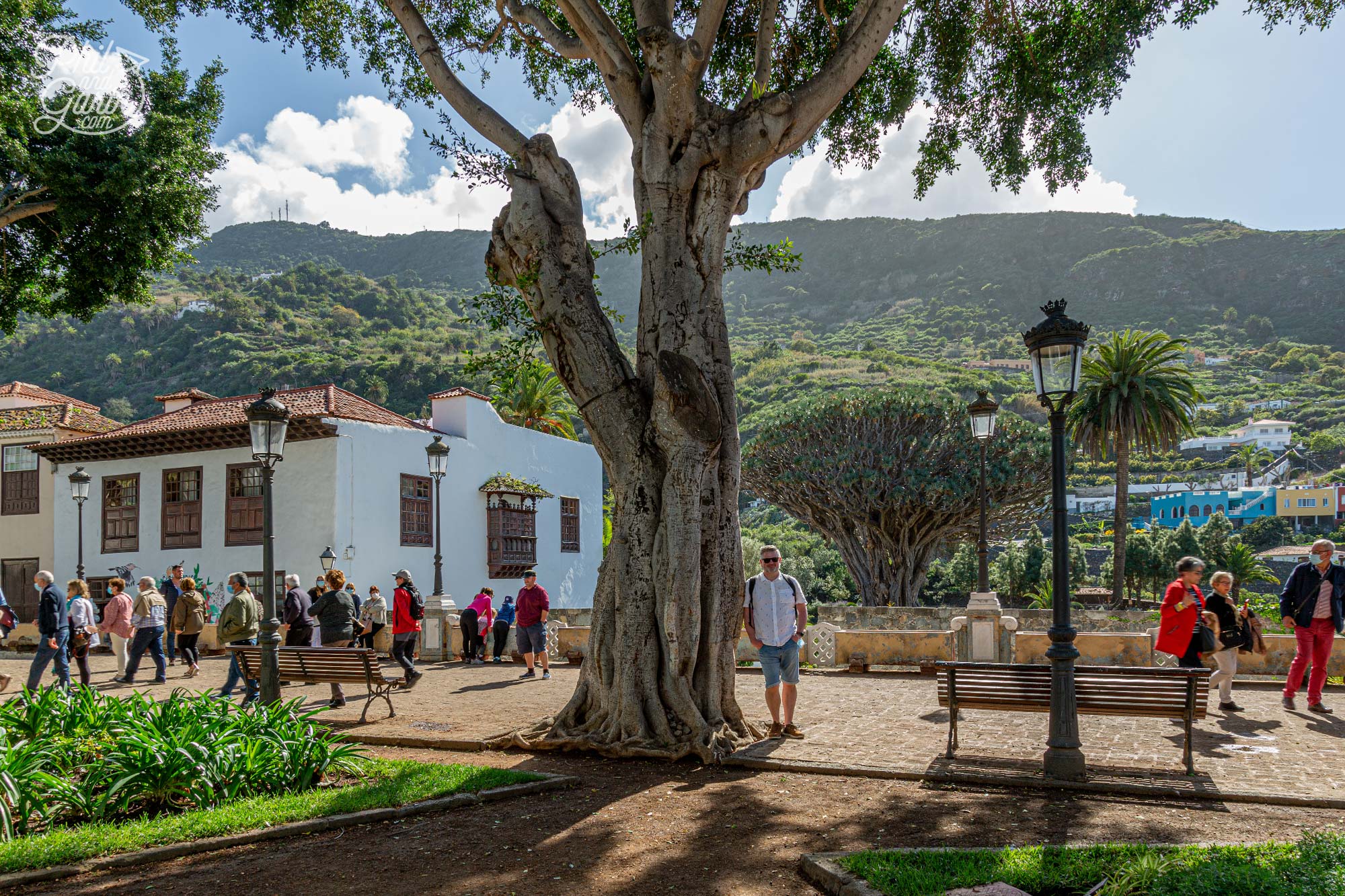
You can easily view the tree from the old town square
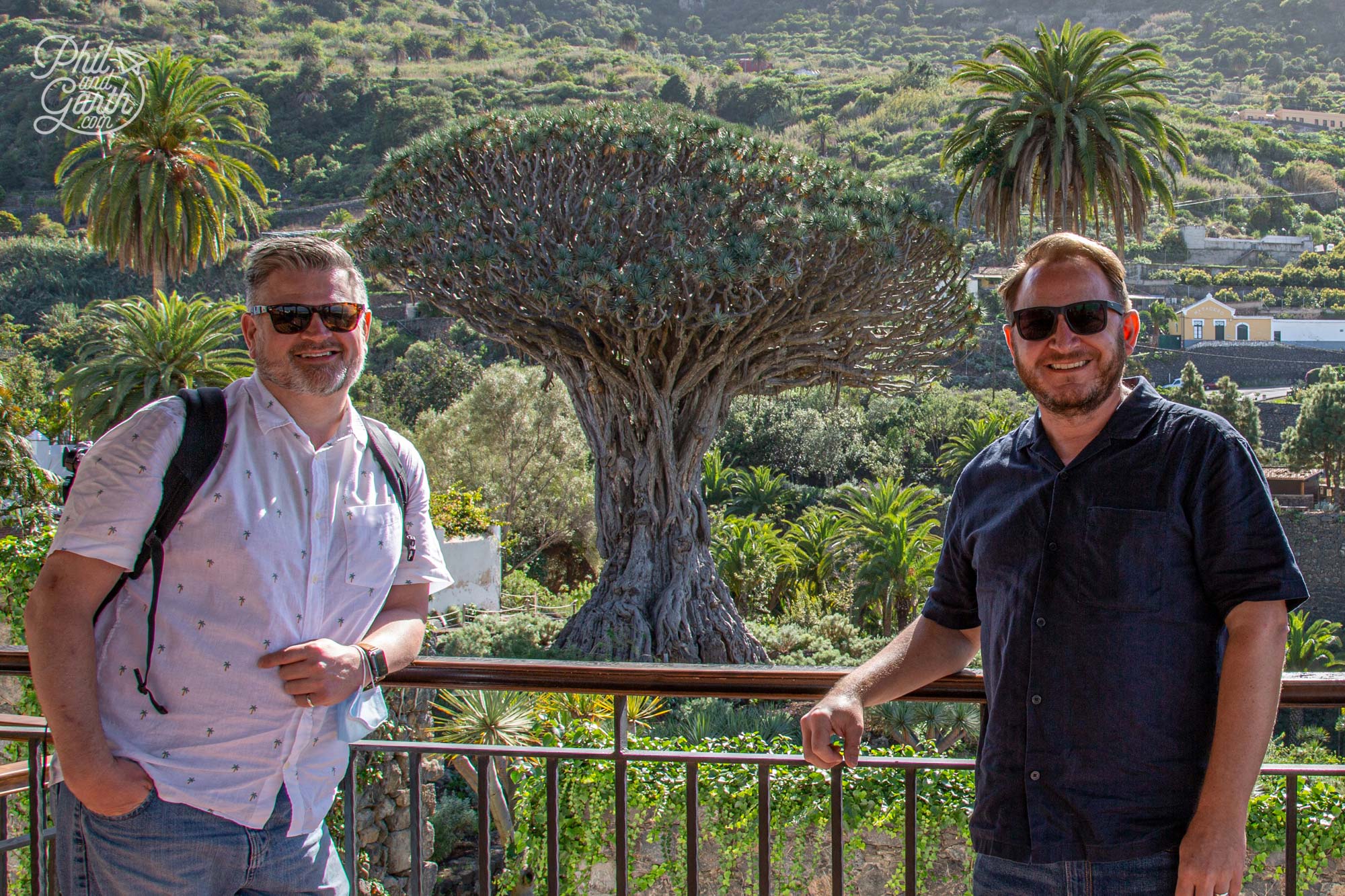
Phil and Garth next to the Millenary Dragon Tree in Icod de los Vinos
8. Garachico
Garachico is a small and picturesque fishing port. It used to be the island’s busiest fishing town and trade port until it was destroyed by a river of lava from a volcanic eruption in 1706. Apparently, it’s referred to as Tenerife’s ‘unluckiest town’ because of its history of disasters. From epidemics (we now know what that’s like!) floods and fires to devastating volcanic eruptions. Garachico’s port was rebuilt on the solidified lava and many natural volcanic rock pools that formed are now one of Tenerife’s hidden gems. These pools that surround Garachico are called El Caletón and are a great place for swimming with the locals in the summer months. But only go in the water when it’s calm.

Great views of Garachico from these sculptures on the promenade

Garachico’s natural swimming pools are called El Caletón
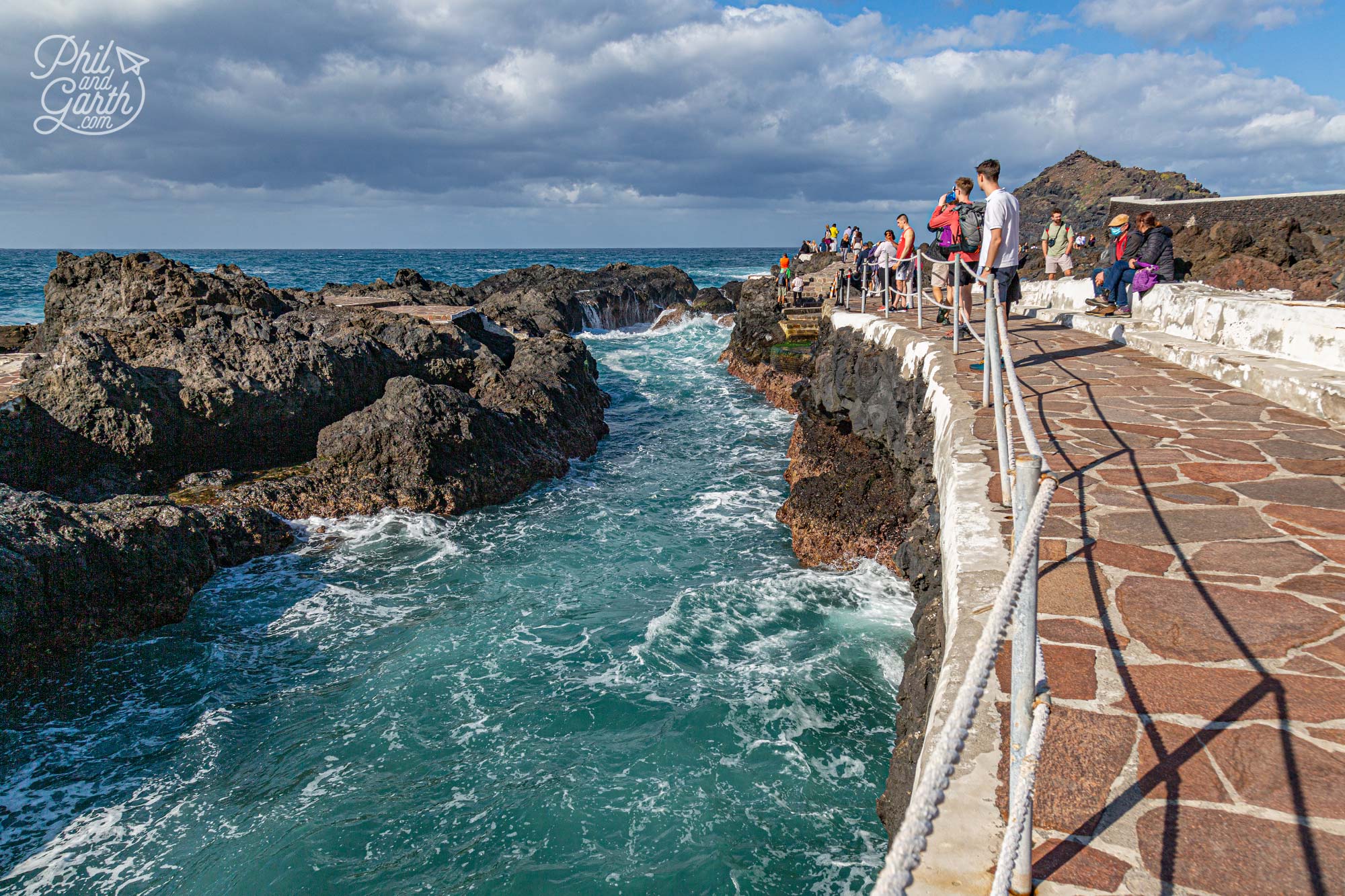
You can only go in the water when it’s calm
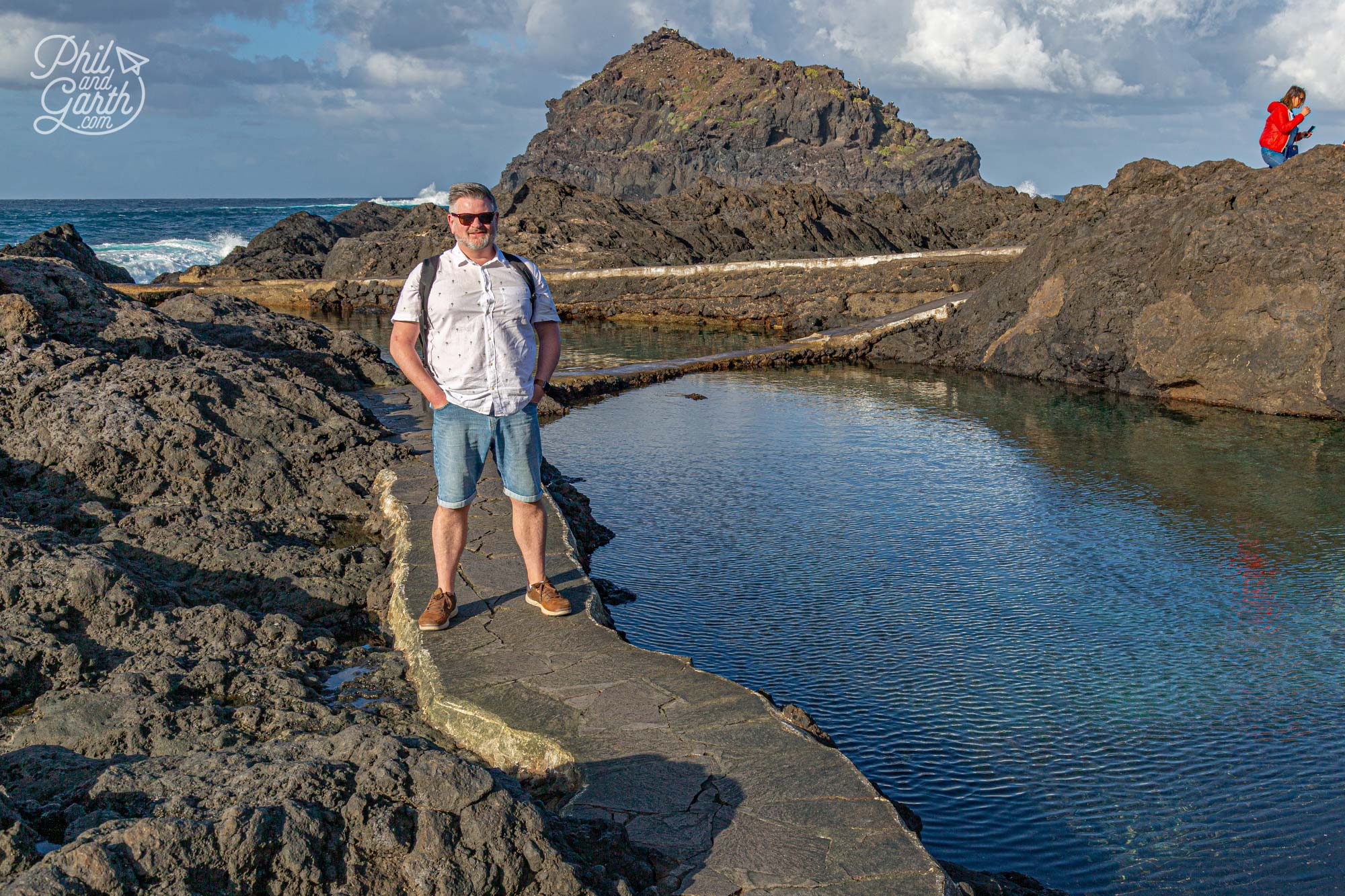
Wandering around these natural volcanic rock pools

Garth wandering around these unique black lava rock pools
This historic town feels stylish with its old fishermen’s homes that escaped the volcanic eruptions. Cobblestone streets lead you to Plaza de La Libertad with some nice cafes and the impressive San Francisco monastery (Convento de San Francisco) dating back to 1526. It’s now a museum with exhibits on the town’s unlucky past. Not far away is a lovely white church – Iglesia de Santa Ana where you can climb the white bell tower for some great views.
We liked Garachico’s laid back atmosphere, it really is unspoilt and one of Tenerife’s best kept secrets. It feels authentic because it has remained largely untouched, there are no big beaches which means no big hotels. The drive to the town took us past loads of banana plantations, we’d never seen so many before.
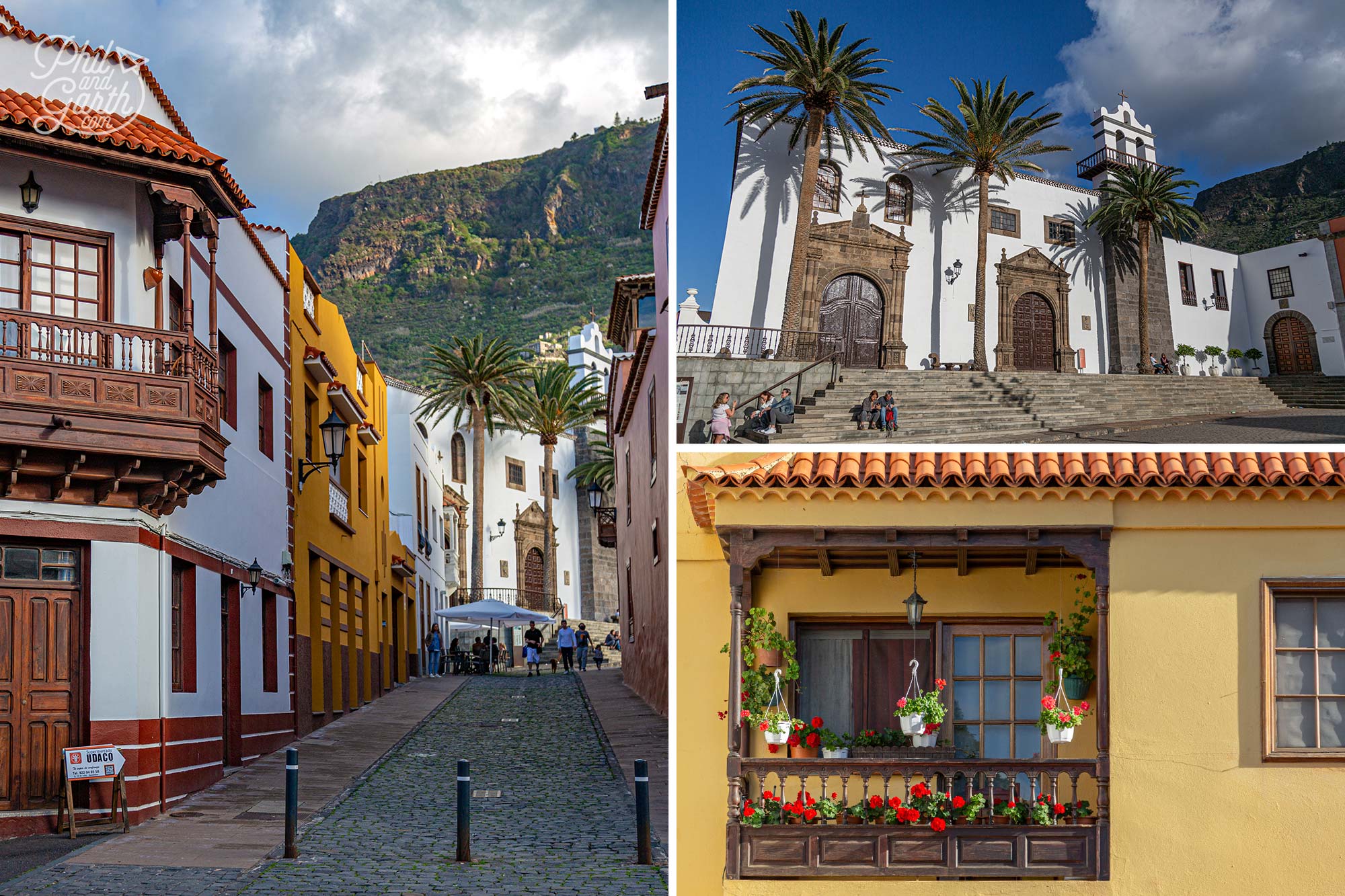
Get lost amongst Garachico’s charming cobblestone streets

Iglesia de Santa Ana is Garachico’s main church. Constructed in 1520, and rebuilt after the volcanic eruption in 1706

Garachico is one of Tenerife’s best kept secrets
9. La Laguna
Our final Tenerife must-see is the unspoilt historical centre of La Laguna or by its full name San Cristobal de La Laguna. It’s situated on Tenerife’s north-eastern tip right next to Tenerife’s capital Santa Cruz. La Laguna was founded in 1496 and used to be the ancient capital of the Canary Islands, so it’s stepped in history and no wonder it’s Tenerife’s second UNESCO World Heritage Site. La Laguna’s 15th-century grid layout and architecture were used as a model and inspiration for building Spanish colonial cities in the Americas like Cartagena in Columbia and Havana in Cuba. The pastel-coloured buildings totally reminded us of our visit to Old Havana, it’s just like stepping back in time.
All the best streets are pedestrianised where you’ll find lots of elegant 16th-18th century architecture, a large number of churches and even palaces. If you want some unique shopping you’ll find bookstores, antique shops and boutique shops. We loved just strolling around the narrow streets listening to the odd street musician amongst only a handful of tourists who visit this unspoilt gem of Tenerife. It’s all very picturesque.

Buildings ooze style and colour in La Laguna Ten

La Laguna is a beautiful and charming town to visit
Start at Plaza del Adelantado if you are driving like we were because there’s a perfectly located large car park here. It’s the oldest square in the city where locals like to meet next to the town hall and art galleries. Then walk to Plaza de Los Remedios to see the impressive Neoclassical facade of the Cathedral of La Laguna (San Cristóbal de La Laguna Cathedral). Built in the early 1900s it’s was inspired by the Pamplona Cathedral on mainland Spain. It’s one of Spain’s few Cathedrals considered to be a work of art. There’s also a lovely artisan restaurant in this area called El Guaydil serving modern and traditional Canarian dishes where we stopped for lunch.

Garth outside San Cristóbal de La Laguna Cathedral

Our delicious lunch at El Guaydil
Then head to the pretty Plaza de la Concepción for the Catholic church Iglesia de la Concepcion built in 1502. Check out the views of La Laguna from the Tuscany styled stone bell tower. One of the city’s most popular cocktail and craft beer bars, El Rincon de Tintin is located here. La Laguna has been a university town since 1701 which means there are loads of bars and local nightlife to enjoy.

Iglesia de la Concepcion on Plaza de la Concepción

Some nice cafes surround Plaza de la Concepción
From Plaza de la Concepción walk down the neighbouring street – Calle San Augustín to take some nice photographs against the colourful buildings. Also on this street that’s worth a quick look is the pretty courtyard of Iglesia de San Agustin (The Church and Former Monastery of St Augustine). It was consumed by a fire in 1969 what remains today are the ruins.

The pedestrianised Calle San Augustín is great for photos
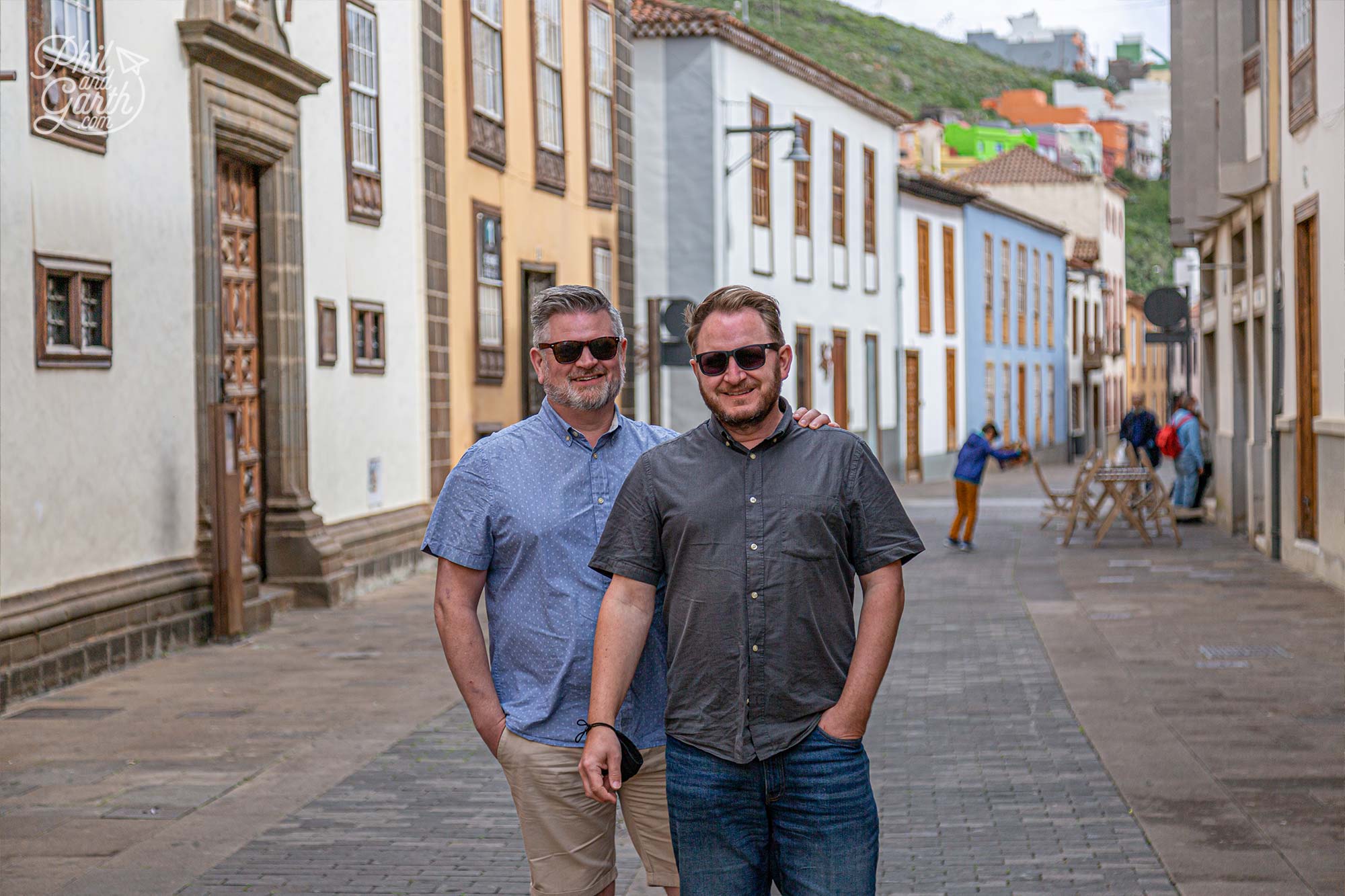
Calle San Augustín – one of La Laguna’s perfectly preserved streets
10. El Arco de Tajao
Our final quirky Tenerife stop are the natural rock formations of El Arco de Tajao. To get to Arco de Tajao, come off the TF1 motorway at junction 46 and park up next to the food truck. It’s then just a 10 minute walk to the arch. You can easily walk across the top or go underneath for some creative photography. We were hoping to catch the sunset but got there a little too late in the evening.

Phil and Garth at Arco de Tajao – a brilliant spot on Tenerife for photography

Arco de Tajao, Tenerife

Arco de Tajao was formed by years of water erosion

It might look like it’s from the American Midwest but it’s actually not far from Tenerife South Airport
Tenerife Practical Information and Useful Advice

Phil and Garth’s top 5 Tenerife travel tips
Phil and Garth’s Top 5 Tenerife Tips
- Tip #1: Download the AEMET app for accurate local weather forecasts.
- Tip #2: Don’t leave anything valuable in your hire car when parking at Masca Village.
- Tip #3: Lots of places are closed on Mondays, so check in advance.
- Tip #4: Pack warm clothes for cold evenings in winter months like February.
- Tip #5: In La Laguna go to the tourist information office for advice on free walking tours.
Google Map Of Tenerife Things To Do
7 Day Tenerife Itinerary
- Day 1 – Fly to Tenerife, and enjoy the pool at your accommodation.
- Day 2 – Teide National Park / Roques de García / eat at Finca Tres Roques.
- Day 3 – Los Gigantes & take a whale-watching boat trip / eat at the marina.
- Day 4 – El Puertito for lunch, beach and snorkelling
- Day 5 – La Orotava / Millenary Dragon Tree / Garachico.
- Day 6 – La Laguna afternoon / Arco de Tajo
- Day 7 – Masca Village early morning / B&B afternoon.
- Day 8 – Fly home.
Tenerife FAQs
- Best time to visit Tenerife? Between July and September, when it hardly ever rains.
- Worst time to visit Tenerife? December is the wettest month with 52mm of rainfall.
- What is the best hotel in Tenerife? The 5 star Ritz Carlton Abama is also very photogenic.
- What’s the best Tenerife souvenir to take home? Aloe vera products are made locally in Santa Cruz, the capital of Tenerife.
- What movies have been filmed in Tenerife? Planet of the Apes (1968), Jason Bourne (2005), Dr Who The Witch’s Familiar (2015), In The Heart of The Sea (2015), Clash of the Titans (2010) and Hitchhiker’s Guide to the Galaxy (2005).
How We Did Tenerife
- We visited at the end of February. The average day temperature was 21ºC and it was cold in the evenings, so do wrap up warm.
- We bought flights from Manchester with TUI.
Our B&B Accommodation
A quick word on our lovely Tenerife B&B accommodation, Finca La Barca. It’s a gorgeous hidden gem of Tenerife and it didn’t cost us loads. The peaceful garden and the swimming pool are a real delight, Garth loved swimming to the sound of the love birds in the aviary. Phil thought the pool is like something from Bali (can even order a floating basket for a special occasion). Owner Joanne gives everyone a bumper continental breakfast every morning with local produce like avocado and peppers. The B&B has a lovely atmosphere in the evenings with ambient chilled out music and classy garden lighting.
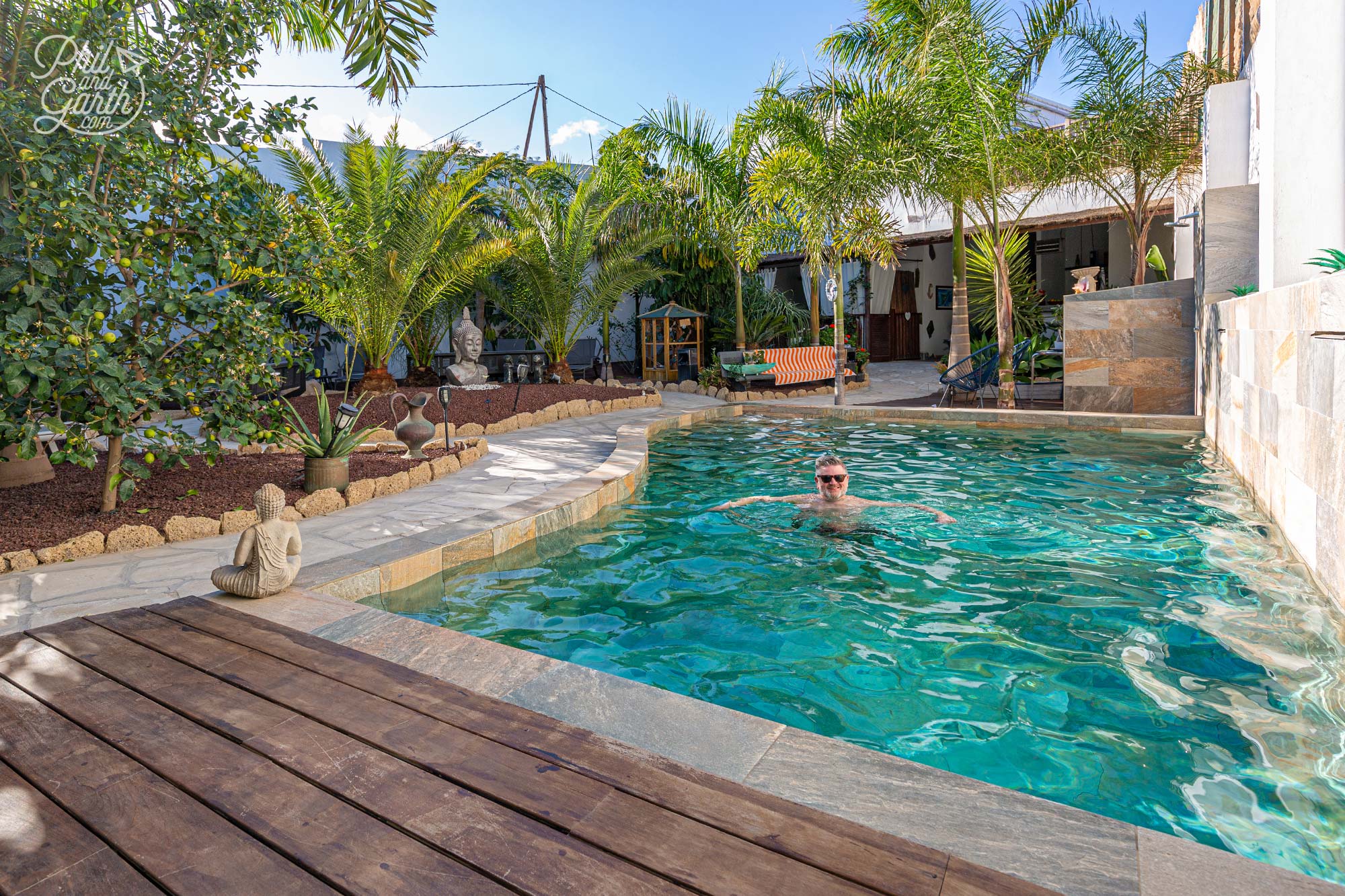
Phil enjoying the Bali style pool at Finca La Barca BnB

Incredible value breakfasts at Finca La Barca


